Desk of Contents:– Introduction– Unboxing,Look, and Really feel– Optical Efficiency– Laser Efficiency– Different Onboard Sensors– Ballistic Software program– Abstract and Conclusion– Background on Ballistics Calculation, Modeling, and Utilized Ballistics Elite– Background on How Laser Rangefinders Work– Background on the Challenges of Getting Optical Efficiency from a LRF Bino– Background GPS Mapping with BaseMap:
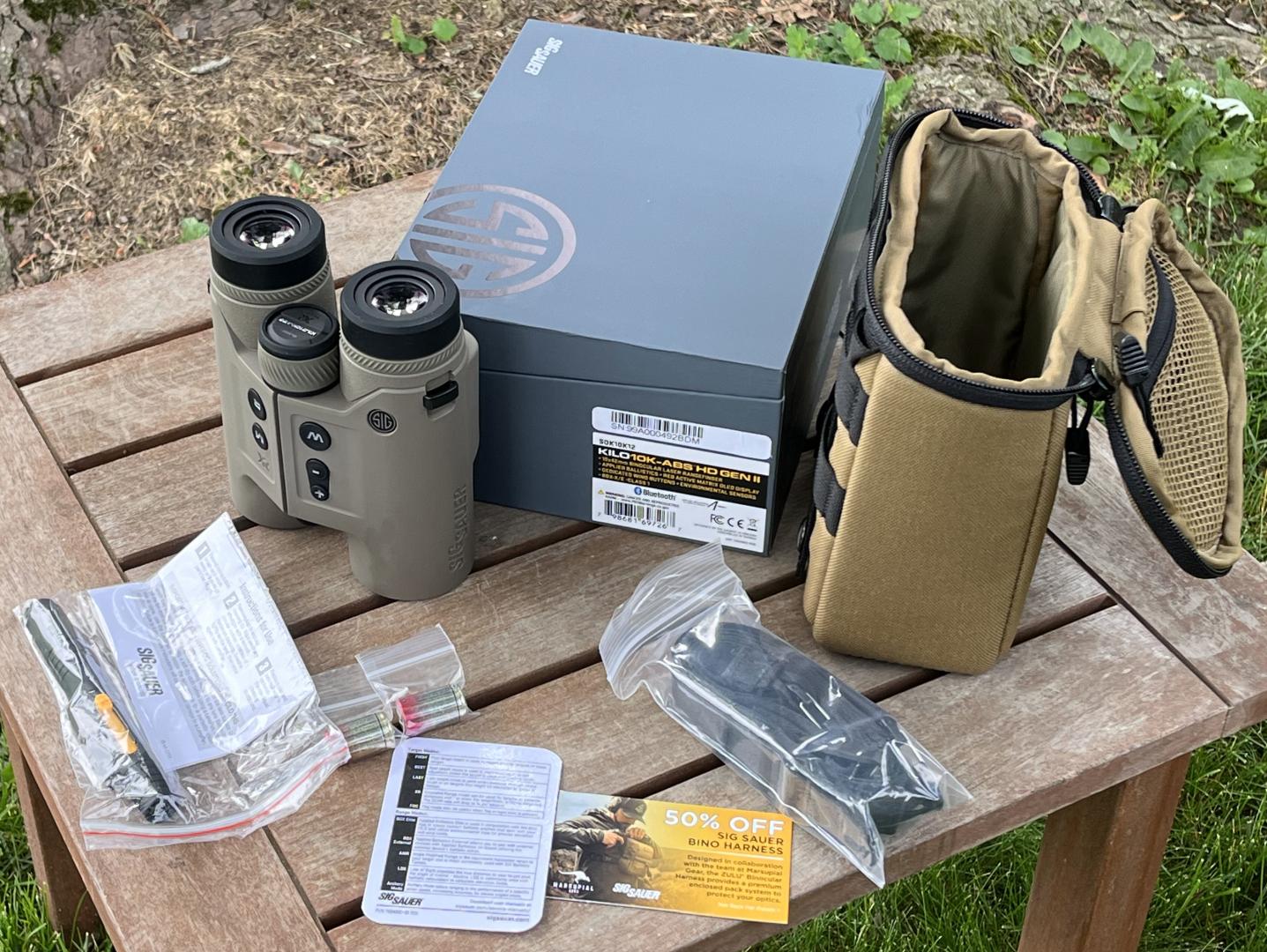
Introduction:
As you already know, the Sig Kilo 10K-ABS HD Gen II is Sig’s observe as much as their blockbuster first era Sig Kilo 10K-ABS HD rangefinding binoculars that I reviewed in 2022. At their launch, the 10k’s greater than doubled the efficient vary of any competing 905nm rangefinding product, added a primary at school 304×256 pixel AMOLED show, featured a reticle that could possibly be zeroed by the person, included Utilized Ballistics Elite baked in, and could possibly be utilized in live performance with Sig’s Ballistic Knowledge eXchange 2.0 system to mechanically ship vary and drop compensating data to a BDX scope that will then illuminate pixels on the scope to point the goal level corrected for drop. For extra on that, please reference my article on SmartScopes and the Sig BDX 2.0 system. I extremely advocate this text because the BDX 2.0 system is a revolutionary product making profitable lengthy vary goal engagement remarkably easy and considerably tougher to mess up underneath the stress of the second. After all, the Gen II 10k’s are a part of the BDX 2.0 ecosystem simply as their predecessors had been.
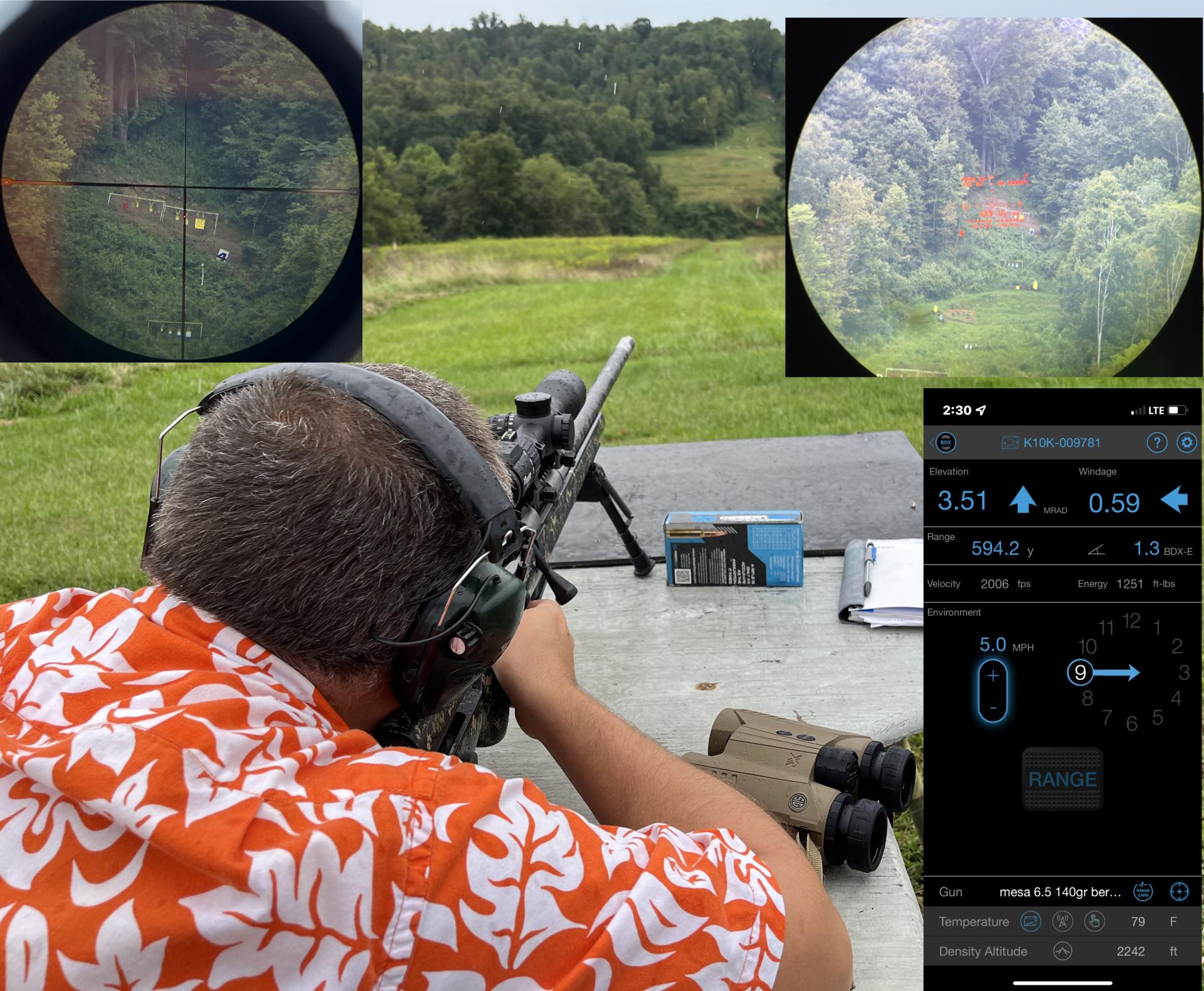
With the second era of Kilo 10k-ABS HD rangefinding binoculars, Sig seems to be to handle the 2 largest factors of customers suggestions. These had been the blue tinted picture attributable to the notch filter for the show and the problem of manually adjusting wind pace and course when utilizing the binoculars with out the smartphone app.
Having carried out numerous critiques on laser rangefinders with ballistic software program integration now, I’ve recognized some core background data that I imagine is vital to topic however not distinctive to anyone product. I’ve moved this data to those background sections following the conclusion the place they are often discovered by anybody who has not learn any of my earlier critiques however skipped by those that have learn a earlier assessment containing the identical data such because the Leica Geovid Professional 32 assessment or Sig Kilo10k-ABS Gen I assessment. Future laser rangefinder critiques may even include this data on this format. I feel this can go an extended method to streamlining my usually overly lengthy product critiques and I could strive one thing comparable on scope critiques sooner or later.
Unboxing, Look, and Really feel:
Any person of Sig’s merchandise will probably be unsurprised to study that the Sig Kilo 10K-ABS HD Gen II binoculars are available a really good trying premium Paperboard field with a hinged lid. Contained in the field, the contents have modified a bit from the primary era 10k models. Whereas the 2 included C2 batteries are the identical, a lens pen has been added and the small house owners handbook has been changed with a pleasant laminated reference information with a pleasant fast rationalization of a few of the modes and a QR code to hyperlink to the handbook. Oddly, the cardboard seems to be about bank card / pockets measurement however is definitely about 20% bigger. I perceive that having a pockets marks me as over the hill lately so I suppose that measurement differential will probably be meaningless to most customers however it nonetheless appears unusual to me. When utilizing the hyperlink to the handbook on the not fairly pockets measurement card, you land at a immediate that directs you to all Kilo sequence manuals. Sig’s manuals are fairly wonderful and I extremely advocate studying although the entire 10k handbook. It incorporates many screenshots of the binoculars and utility menus and is kind of useful in navigating the machine. It’s also more likely to reply any questions you may generate that I didn’t deal with on this assessment. Sig’s manuals are, with out query, the very best within the business.
In all probability essentially the most significant change when it comes to included extras from the primary era is the omission of the WeatherFlow wind meter. That is most likely not too stunning as integration of Calypso ultrasonic wind meter performance inside Utilized Ballistics Elite looms and, based mostly on posts I’ve learn, few customers of the primary era Kilo 10k models seem to have used the wind meter primarily discovering it restricted in vary, time consuming to interface with, and usually extra hassle than it was price to combine into their taking pictures course of. By the way, the WeatherFlow performance has not been faraway from the Gen II Sig 10k binoculars or the BDX app. I’ve examined the earlier WeatherFlow meter with the brand new Gen II binos and it really works advantageous. I imagine these included meters had been regular WINDmeters and never a particular version, so, it’s doable a $60 WINDmeter would work for individuals who really need that performance.
Additionally gone from the primary era 10k’s gear is the binocular harness. This has been changed with a case and a coupon for 50% of a Sig branded Marsupial Gear gen2 no-mag enclosed binocular pack (SOZBH202) by way of the Sig web site whereas provides final. Whereas I don’t just like the Gen 2 marsupial gear bino pack close to as a lot as I did the Gen 1, that is nonetheless a really good coupon and a superb compromise for individuals who would have most popular a binocular harness corresponding to the primary era Sig 10k got here with to the case the second era comes with. Selecting what kind of case to incorporate with a set of rangefinding binoculars is kind of the dilemma for producers as totally different product use circumstances argue for very totally different case options. For vary use and storage, a easy padded case is finest whereas, for searching use, a harness is probably going most popular. Sig has chosen a properly padded easy case with excellent high quality building. This isn’t stunning as Marsupial Gear manufactures it for them. The case has a small mesh zipper pocket within the inside the lid and has MOLLE loops on the again. I actually don’t mid the selection of a effectively manufactured easy case that’s wonderful for storage, transport, and vary use rather than the binocular harness. Nonetheless, the zipper closure high with no latch doesn’t will let you carry the pack with the strap protruding out to be used. I discover this unlucky, as that is how I usually carry optics too and from the vary and even how I are likely to retailer them. Additionally, the pocket would higher on the surface of the padding and accessed from exterior the case as the delicate lenses are higher protected on this approach. You don’t really need the battery you might be more likely to be carrying within the pocket to be instantly on the eyepiece in case you drop the case. That is very true for the reason that 10k’s don’t include the standard thick rubber eyepiece cowl that usually comes with binoculars. After all, a carry strap can also be included to hold the binoculars with. It’s a fairly perfunctory instance, with no padding and an uncommon attachment system using small plastic HK-style snap hooks that connect to the binoculars with little sewn loops.
Stylistically, the Gen II 10K binoculars are a fairly vital departure from the originals. Gone is the cammo on the harness, changed with a tan carry bag. The FDE on the unique binoculars has been changed with tan on the Gen II models. A lot of the aggressively styled knurling in every single place current within the unique binoculars is now toned down. Knurling on the Gen II unit is rather more subdued. In most locations that is purely aesthetic. Nonetheless, in relation to the main target wheel, it’s a considerable perform enchancment in addition to the brand new knurling is far simpler to show with only one finger as the big flats on the primary era models weren’t nice for this.
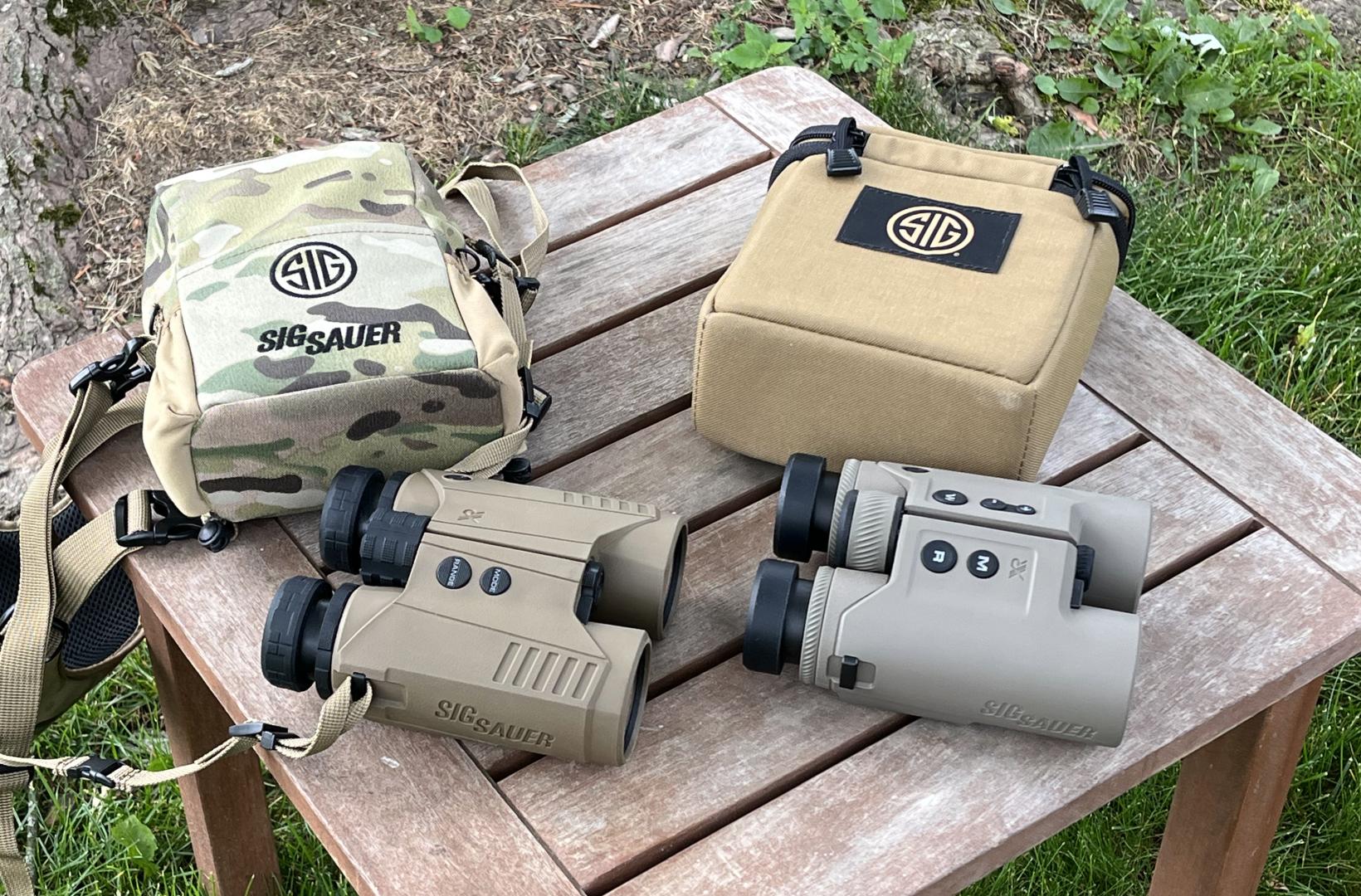
Regardless of the change in styling, the Gen II 10k models are very shut to precisely the identical dimensions as the primary era. They’ve the kind of blocky really feel frequent in rangefinding binoculars and customers with small to medium fingers will discover the controls a stretch for single-handed use. The up to date knurling on the main target knob is a considerable help on this over the primary era models however it’s nonetheless a little bit of a attain and slightly on the stiff facet. The 10K’s are merely a greater match for 2 handed use with my medium sized fingers.
The change in styling for the Gen II’s has made mounting of a cinch tripod adapter simpler on this era because the rubber armor on the target space has had the aspects and angles eliminated and is now utterly spherical. Sig nonetheless features a tripod mounting stud behind the ornamental Utilized Ballistics emblem within the entrance of the hinge level for his or her tripod mount as effectively. I picked up one Sig’s Zulu bino adapters to check out with this throughout this assessment. I ended up preferring each the cinch strap kind answer and simply holding the binos on high of a bag on the tripod when ranging. There was a great deal of play with the Zulu adapter that made it arduous to get it to remain the place you wished it heading in the right direction when ranging. It’s cant adjustment additionally didn’t get very tight, and it was a PITA to need to take away the bottom of the adapter and stash it someplace to suit the binos again within the case. The adapter most likely isn’t a nasty match for hen watching however wasn’t nice for making an attempt to exactly goal a rangefinder off of a tripod.
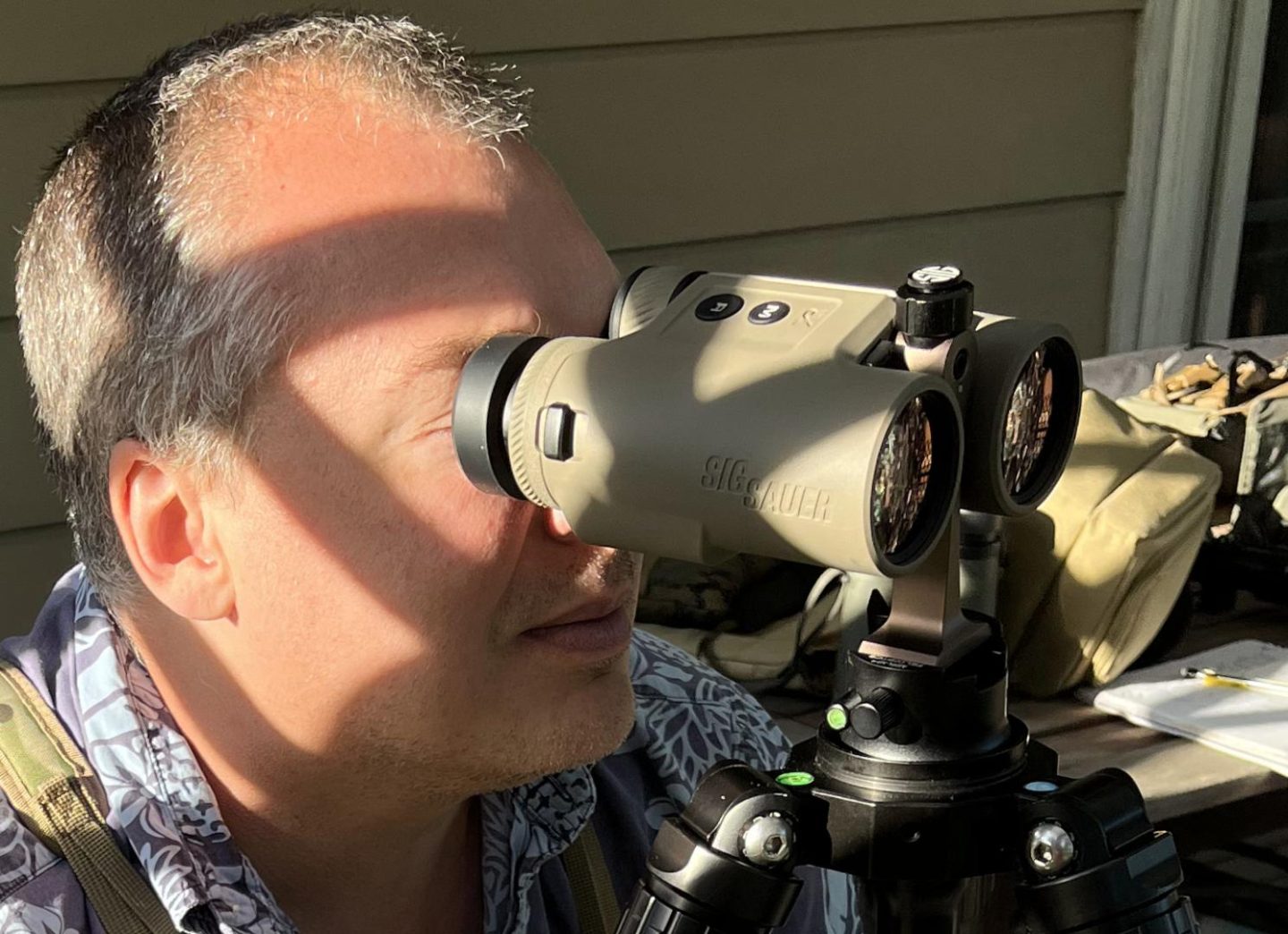
As with the primary era 10Ks, the Gen II models have three place twist up eyecups and rather less eye reduction than most binos of comparable measurement I’ve used. The Eyecups are 1.858” in diameter. It is a little smaller than the knurled styled ones on the Gen I models and I discovered they felt slightly extra snug regardless of the distinction being miniscule. As with different rangefinding binoculars, each proper and left lenses have a diopter on them. Each of those are non-locking on the 10Ks however are stiff sufficient they don’t seem to be going to maneuver inadvertently. One other enchancment for the reason that first era 10K binoculars is the tooless battery cowl with built-in T-handle. Not solely does this maintain you from having to dig for a coin or Leatherman, however it additionally makes it a lot simpler to get the quilt straight and never cross-threaded once you put it again on.
As with each different vary discovering bino I’ve encountered, the rangefinding show within the 10ks is in the best barrel solely. This show is kind of full. As pictured beneath, you’ll be able to see that the pre-range important show consists of the bearing, density altitude, reticle, ballistic profile loaded, goal mode, wind setting, and battery remaining. The display screen introduced up after ranging is equally full and consists of angle modified vary, inclination, bearing, density altitude, reticle, yards to focus on, drop, windage maintain, velocity of the spherical at goal, and power of the spherical at goal. This extremely full HUD is made doable by Sig’s distinctive 304 x 256 pixel AMOLED display screen. I ought to word that initially I assumed the show in my check binoculars was canted a pair levels counterclockwise. You’ll word that it seems so in most of my photographs. It is because I’ve a large head. The show is leveled for the typical, 66mm inter-pupillary distance. Mine is 75mm and adjusting for this tilts the show. That is extra noticeable within the Sig than in different binos as a result of it options lengthy traces of straight textual content and likewise a reticle with a crosshair. There aren’t any useful impairments ensuing from this melon head induced show cant. Sig’s pixel-based show makes doable the superb onboard menu system which doesn’t want to make use of obscure three letter acronyms you’ll inevitably neglect for every thing. The menu makes it straightforward to make the most of the binoculars with out being linked to the BDX utility within the discipline. That is even so when needing to make use of a number of ballistic profiles, because the binoculars have the reminiscence to retailer thirty profiles. The shows and menu system are merely wonderful. Consequently, within the two years since I reviewed the primary era 10k unit I’ve nearly solely used it because the rangefinder and ballistic calculator on journeys to the vary and nearly by no means had it linked to the appliance whereas doing so. The show additionally makes it doable to have a perform permitting the person to zero the reticle inside limits. That is fairly good as rangefinder beams are seldom completely aligned with the reticle and customers usually need to memorize their alignment or maintain slightly cheat sheet of their binoculars case as a way to bear in mind the optimum goal level. You will see that the zeroing perform for the 10ks underneath the settings gear within the higher proper of the rangefinder web page within the BDX cellphone app. It’s close to the underside and can convey up an alignment mode operated by way of the cellphone. You may alter plus or minus 5 increments in each the vertical and horizontal. On the primary era 10k’s this allowed me to zero the reticle. Sadly, this gen2 set is slightly additional off and I would like round 4 extra increments within the vertical. The ensuing finest zero setting locations the true goal level close to the highest of the central plus signal on the reticle I selected.
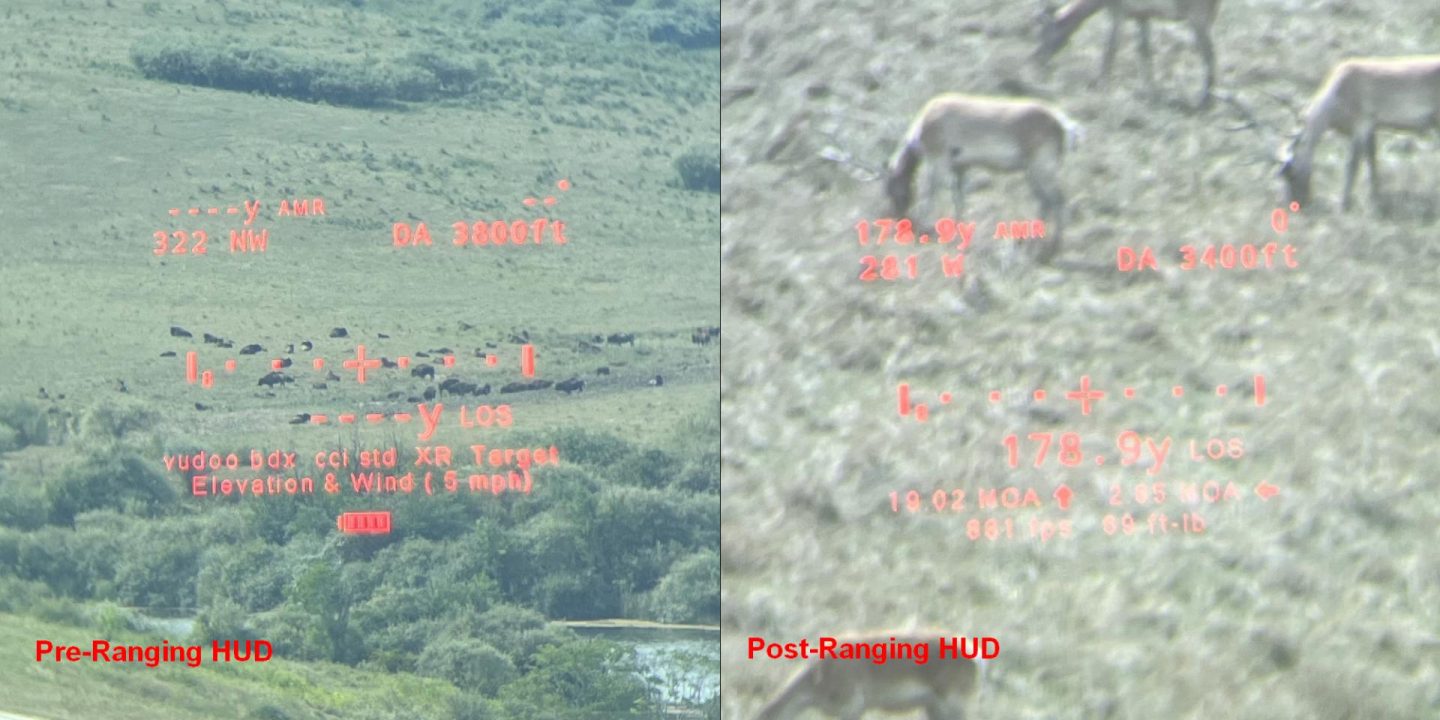
The very last thing I’ll speak about on this part is the three new buttons added to the left tube that weren’t current within the first era 10K models. These had been a giant request of aggressive shooters and permit for speedy enter of wind information with out having to be linked to the cellphone utility. Beforehand, this perform was buried underneath two totally different features in the primary menu system. There was one menu choice for wind pace and a second for course. On the Gen II, when in fast mode, you’ll be able to simply hit the plus or minus keys on the left barrel to vary the wind pace and faucet the W key to convey up a course menu the place the course modifications with the plus and minus keys. There’s additionally a hunt choice for the wind keys discovered underneath the function settings. This mode requires holding the W key to start out a mini wind setting wizard. Both setting is kind of intuitive and tremendously faster than was beforehand doable. The brand new wind keys may also be used to navigate round in the primary menu with the plus and minus keys transferring your choice up or down and the wind key performing to pick out choices. That is an enchancment over the earlier system as you’ll be able to transfer up and down within the menu now whereas beforehand you may solely transfer a method and needed to go all the way in which round in case you clicked previous the choice you wished.
Optical Efficiency:
The function in daring on Sig’s 10K Gen II web page is the discount of blue tint. With out query that is the largest change from the Gen I models. So, we could as effectively begin speaking about optical efficiency by speaking about tint. In any case, the primary Gen 10K’s assessment did. After all, it’s totally different this time. The Gen II binos don’t actually have any perceptible tint to their picture underneath pure circumstances. If you wish to understand any tint in any respect you actually need to create artificial circumstances corresponding to taking a look at a white wall underneath indoor lighting after which switching backwards and forwards between the best facet that has the notch filter and the left facet that’s with out one on the Gen II models. Below these circumstances, you’ll be able to confirm that there’s a notch filter. You already knew that although. All rangefinding binoculars have a notch filter. This time although, you received’t see any inform story tint in actual world use. It’s that massive of an enchancment.

As with my assessment of the Gen I 10K binos, I took fairly just a few totally different comparability images of various scenes as a way to put collectively a comparability picture that I imagine effectively illustrates the blue tint within the Gen I binos. On this case although, the comparability is with the Gen II models. These images haven’t been put up processed in any approach past resizing, gluing collectively and labeling. Enjoyable truth in regards to the suspicious trying bushy central darkish inexperienced tree within the photographs, simply as within the well-known Monty Python “How to not be seen” skit, there are the truth is two folks in these images not being seen. They’re behind the darkish central bushy tree, not being seen. They didn’t undergo the destiny of any of the folks not being seen in that Python skit, a skit you’ll most likely now be googling, for which you might be welcome.
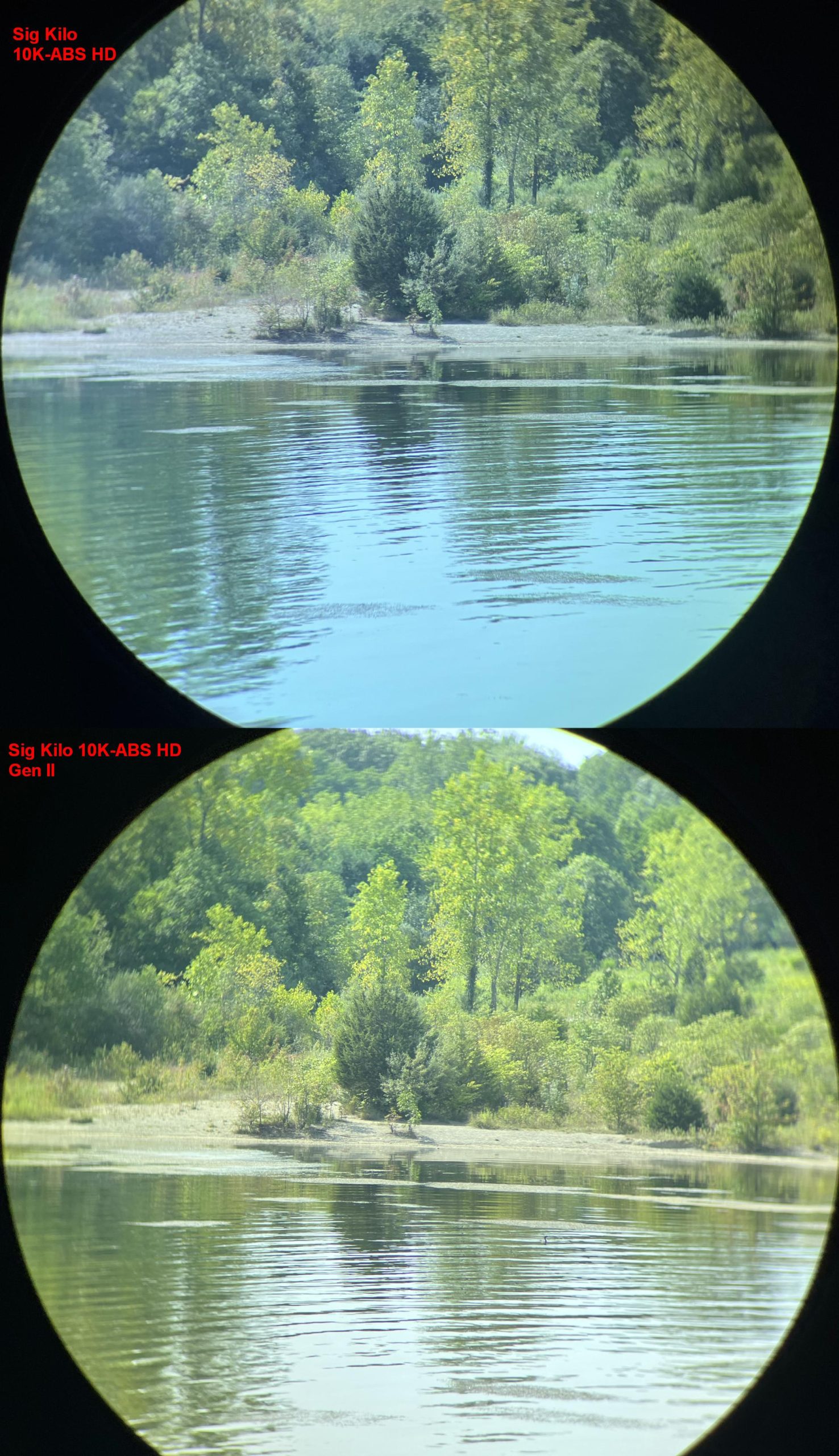
The factor that struck me most in utilizing the Gen II models as in contrast with the Gen I models was not particularly the absence of the blue tint, however reasonably how rather more vibrant the picture seems. I hope that I’ve captured that within the comparability as a result of it modified how I really feel in regards to the optical efficiency fairly a bit. The primary Gen 10K models carried out fairly effectively on most of my particular optical testing. These are assessments to find out decision, chromatic aberration, distinction, Depth of Area, and edge-to-edge readability. I positioned them as slightly behind Zeiss Conquests and about equal to Vortex Fury 5000’s in general optical efficiency. My conclusion was subsequently that the tint actually wasn’t a giant deal. It didn’t appear to dam a lot gentle because the low gentle efficiency was advantageous relative to different 10×42’s and it didn’t appear to be impacting any of the opposite efficiency metrics a lot both. Testing with the brand new Gen II models certainly helps that unique line of reasoning. Each the Gen II and Gen I models are primarily similar on decision, chromatic aberration, edge to edge readability, and so on. They mainly appear like the identical optical system with out the noticeable blue notch filter.
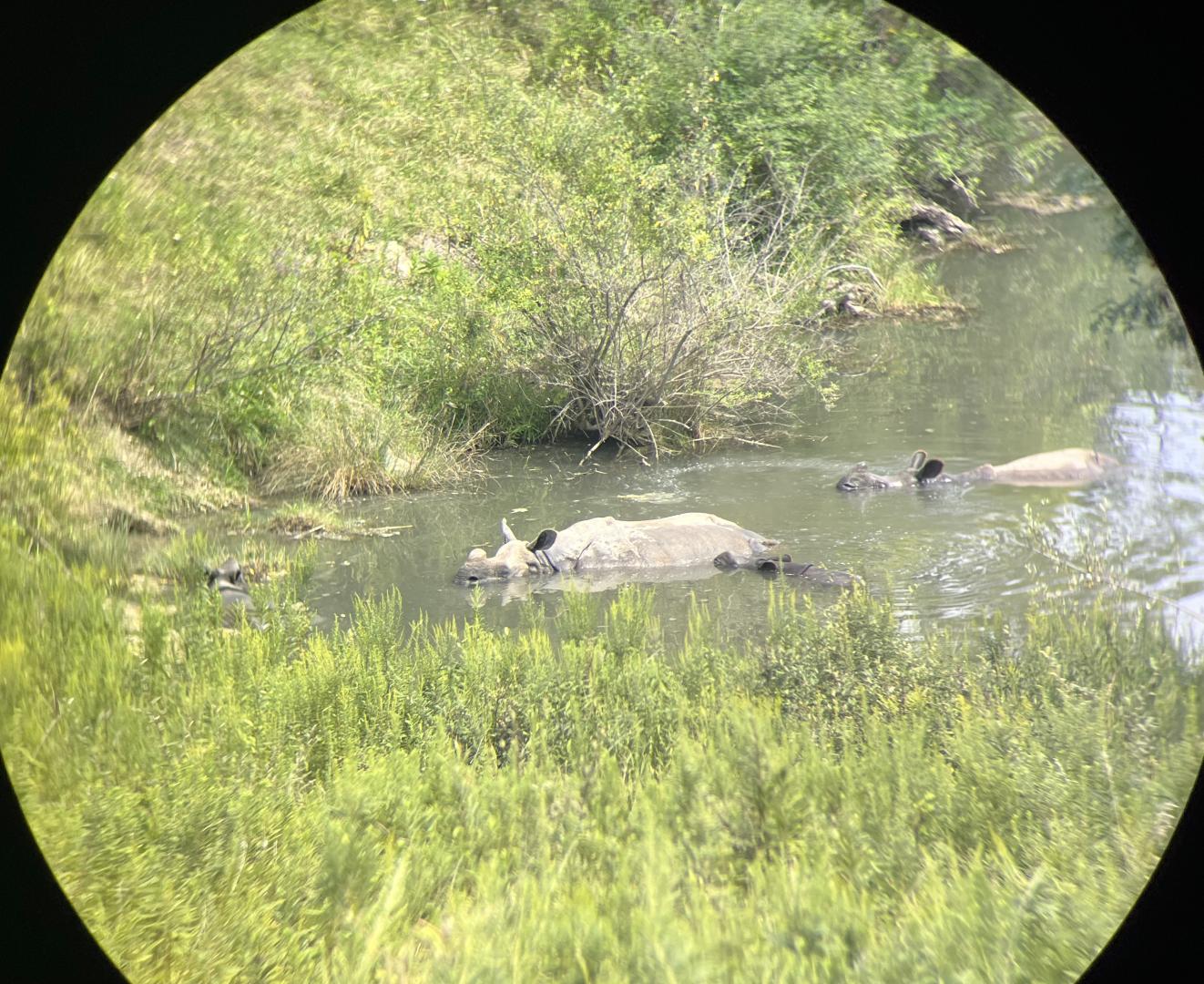
My conclusion in regards to the blue not being a giant deal based mostly on that reasoning was however incorrect. Simply take a look at how rather more vibrant the Gen II picture seems and the way the blue tint makes the Gen I picture seem grey and flat. It might not present up on the metrics, however when it comes to person expertise, it was a giant deal. I got here away from the primary era models discovering them optically mediocre. They had been ample as a rangefinder and it was price it as a tradeoff with the superb 304 x 256 pixel AMOLED show however they weren’t one thing I loved as binoculars per say. Had I been score them as binoculars alone, not understanding that they had a rangefinder perform that was downright spectacular, they’d not have carried out effectively. The view although the Gen II binoculars however seems to be rather more vibrant. I truly like utilizing them as binoculars. On optical testing they’re nonetheless behind the Leica Geovid Professional’s and the Vectronix Vector X’s by precisely the identical quantity the Gen I models had been however by producing a shiny and vibrant picture they really feel nearer to these models when your utilizing them in they discipline than they do to the Gen I unit. The blue being banished is a giant deal. I’m glad they had been capable of accomplish it and I’m certain it’s price no matter larger battery consumption it prices to spice up the show brightness. I would add that the battery consumption of the AMOLED show is definitely tremendously lower than that of the standard segmented LEDs anyway. The AMOLED takes one thing like 1/twentieth the ability and this reveals within the very lengthy battery life Sig 10k models have.
Laser Efficiency:
The statistics Sig lists on its web site for the Kilo 10K-ABS HD Gen II laser rangefinding binoculars are precisely the identical as for the primary era models. These are: ranging efficiency of as much as 3k yds on deer, 4k for timber, and 10k for reflective targets. The laser is listed with a beam divergence of 1.5 x .06 MRAD and is 905nm. The one distinction on the spec sheet is the Gen I models had been class 1M and the Gen II are class 1. I inquired and this modification was to adjust to new European rules. In live performance with the change to laser output some modifications had been made to the FPGA that processes the returns. Mixed, the online impact is predicted to be slightly higher rangefinding efficiency. In side-by-side testing with the Gen I unit, I noticed no efficiency distinction between the 2 models. So, no matter modifications had been made within the laser emissions and return sign processing schemes usually are not main.
On the time the primary era 10K models had been launched, their rangefinding efficiency was downright surprising. Basically, they ranged comparable targets in comparable circumstances between 1.5x and 3x so far as the very best competing rangefinders, as exemplified by the Leica Geovid Professional 32’s, relying on the precise goal and circumstances. They did this with a laser that itself was fairly just like the competing models however through the use of extra laser pulses unfold out farther from one another over an extended time and utilizing an improved algorithm to course of these pulses. Sig calls this the Gen II Lightwave DSP Ranging Engine. Regardless of the sophistication of this engine, Sig additional incorporates 5 goal modes permitting the person to make the most of some processing facility of his or her personal in selecting a mode finest suited to the circumstances. These modes are first, final, finest (the fundamental default), XR (prolonged vary), and fog (needs to be known as fog / rain / snow). These modes can change each the laser pulsing scheme and the sign processing to allow higher efficiency in some area of interest situations. The XR and fog modes are notably helpful of their niches.
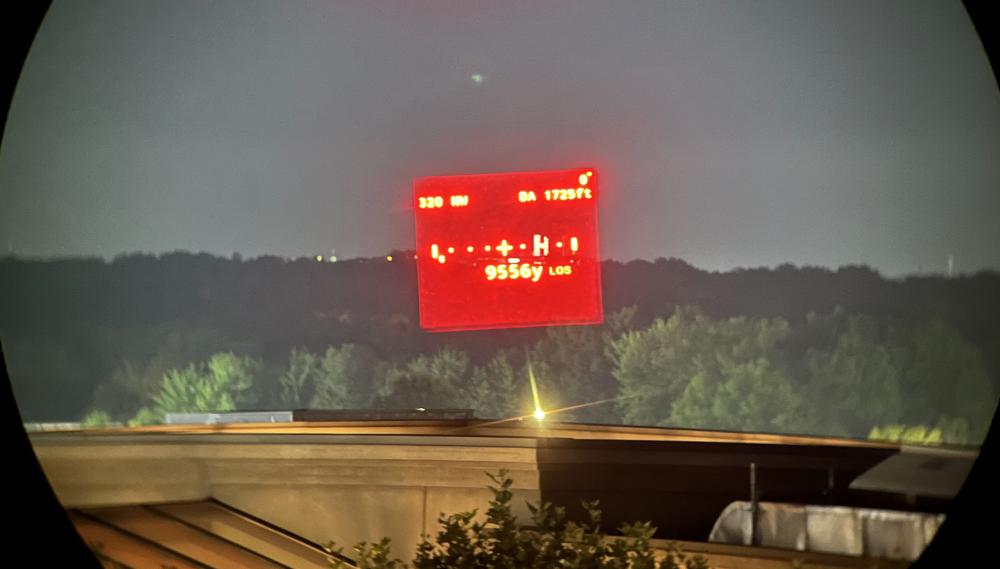
I could as effectively begin out the rangefinding testing examples with the nighttime Budweiser tower vary. I used to be capable of again up just a few yards additional on the parking storage this time and so the vary was 9556 yards. That’s 5.43 miles in case you curious, as I used to be. This isn’t in any respect a troublesome vary to get on the 10k’s underneath evening circumstances. They may return a worth each time. The interstate goes proper by that tower and I drove by it on the way in which to the parking storage to take that vary. It’s a ten minute drive from the tower to the storage regardless of nearly your entire rout being freeway. That basically places issues in perspective. After all, ranging a large manufacturing unit at evening, when you could have primarily no background radiation, is a powerful feat, however not a very powerful information for potential customers.
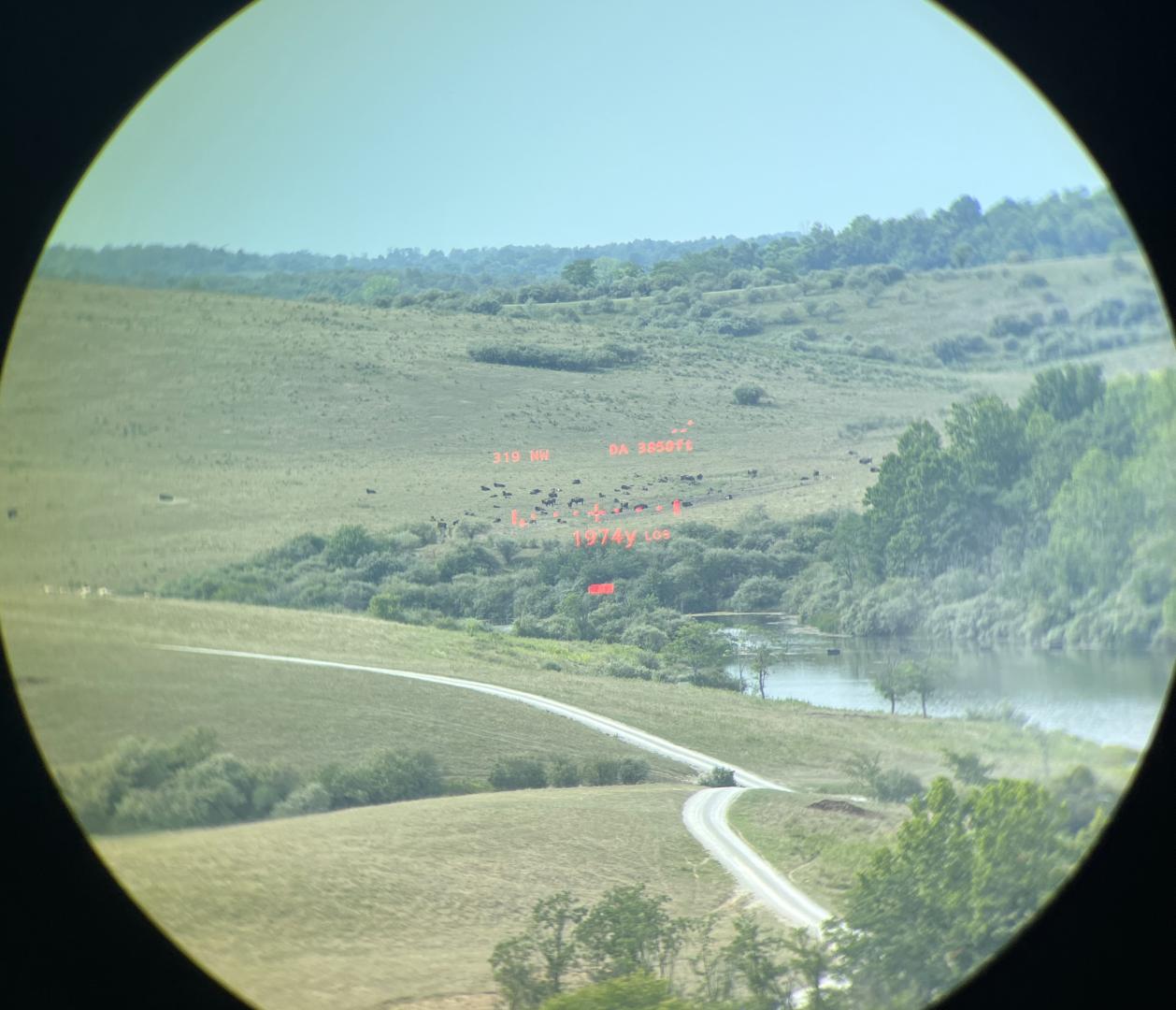
Within the specs Sig lists efficiency of as much as 4k yards for ranging timber. Along with with the ability to do that on overcast days as I used to be with the primary era 10k’s, I used to be truly capable of get fairly shut on a sunny day as effectively. To be clear, the primary era 10k’s additionally ranged close to 4k on this explicit sunny day. For some purpose it was simply not a troublesome as different sunny days have been up to now. This was most likely as a result of the temperature was decrease than on most different testing days resulting in much less stray infrared radiation. Situations matter an incredible quantity and the way troublesome they’re shouldn’t be instantly apparent to the person. For example, on a unique, very troublesome day, I struggled to vary a heard of bison on a well-defined hillside at 2,000 yards. Bison, hillside, getting something was one thing like a one in twenty try proposition. On that very same day, ranging timber on the hillside behind them at someplace round 2,300 was not occurring in any respect. Situations are essential for any laser rangefinder. For the frequent 905nm lasers most rangefinders use, the warmer and brighter it’s the extra issue you’ll have. I’ve spent a while experimenting with this and it seems that you may enhance your outcomes aiming at one thing that’s shadowed close to the goal if doable. This may even matter greater than how arduous and reflective the goal is at instances. After all, if you will get one thing shadowed and arduous like a giant rock or tree trunk that’s finest. Decide your goal effectively. Additionally, I’ve seen a number of speedy ranges yield diminishing probabilities of a return. I anticipate this both has to do with both heating up parts or with quickly drawing down battery voltage. Should you’re making an attempt for a very robust vary, your higher off permitting slightly calm down between makes an attempt. This additionally has confirmed true throughout a number of rangefinding gadgets examined.
Different issues I’ve managed to vary are squishy people at 2,100yards in overcast circumstances, treelines at 5,000yards underneath evening circumstances, and hillsides at 2,400yards. Considerably surprisingly, hillsides appear tougher than timber to vary so I like to recommend timber when you could have the selection. Hopefully that is useful in providing you with a normal thought of what to anticipate when it comes to efficiency underneath explicit situations. Due to the enormous impact circumstances and particular targets have on rangefinder efficiency it’s troublesome to convey to the reader precisely what targets may be excepted to yield a return in what circumstances over a broad scope of doable situations. I discover Sig’s afore talked about claims of best-case efficiency on totally different targets to be affordable nonetheless.
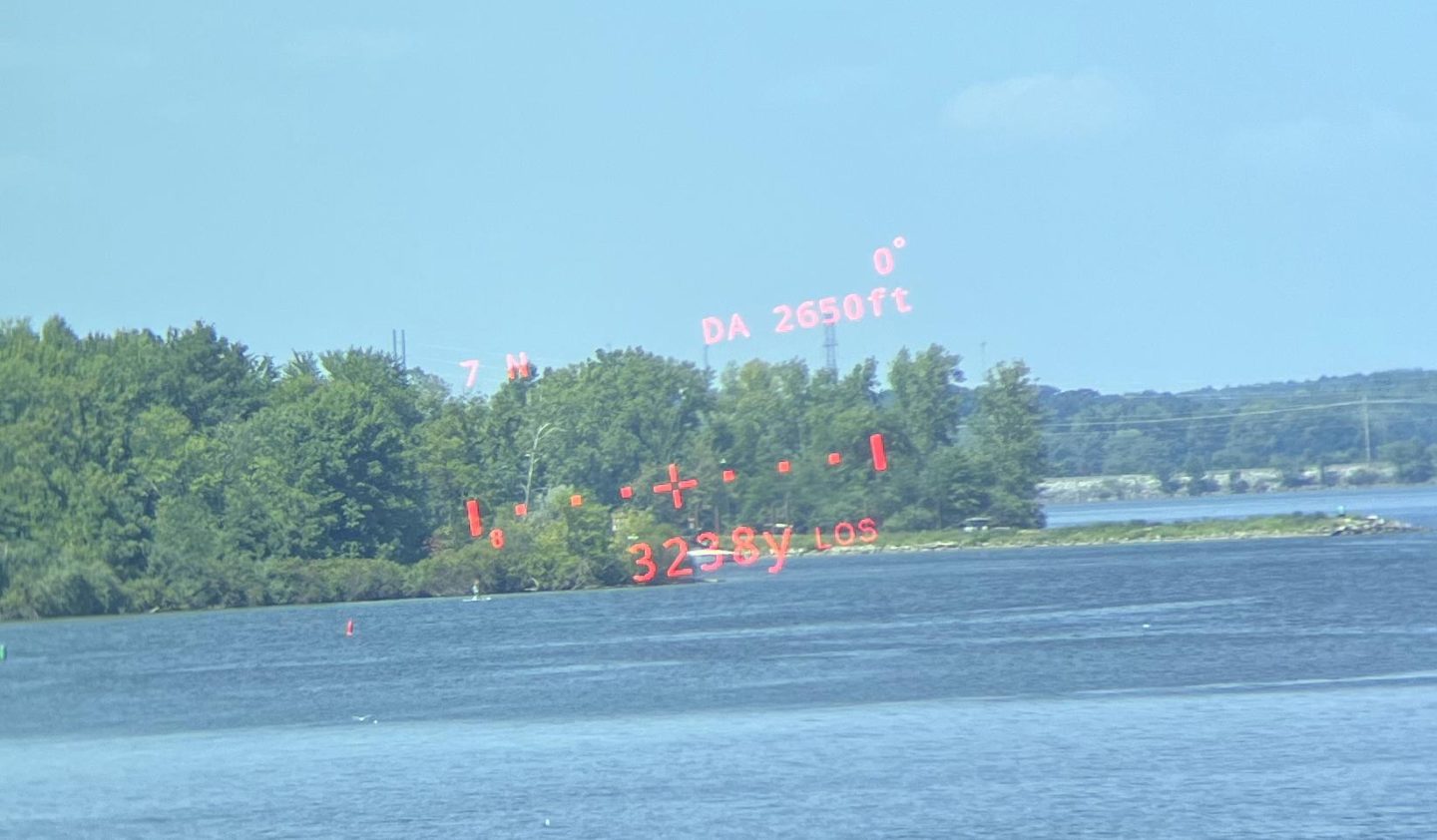
Going into this assessment, one of many comparisons I used to be most all in favour of seeing was the laser efficiency of those class altering Sig 10k’s vs. the Vectronix Vector X rangefinding binoculars that promised to be the primary comparable challenger. One vital word on that: The Vector X unit I’ve is a late stage engineering pattern with FPGA firmware that differs barely from the manufacturing variations now delivery. The remainder of it’s firmware has additionally had numerous updates all through the testing course of and can probably have extra. The FPGA firmware within the Vector X unit I’ve processes noise heavy information extra aggressively delivering extra lengthy vary readings in noise heavy inclement circumstances but additionally extra false readings in those self same circumstances. This can have to be stored in thoughts when making comparisons. My expectation when beginning to evaluate the Vector X and Gen II 10ks facet by facet was to have both a transparent winner or, probably, a efficiency that was indistinguishable as I used to be not sure if they’d be operating the identical rangefinding {hardware} and engine. They aren’t, however regardless of that, the efficiency of the competing binoculars is analogous however with out what I might name a transparent winner. I’ll offer you some side-by-side examples of efficiency variations in addition to some generalities. First off, the Vector X wouldn’t vary the Budweisser tower at evening at 9556 yds. I checked and it isn’t reminiscence restricted on this. It simply doesn’t appear to do in addition to the Sig on arduous targets at lengthy ranges in splendid circumstances. The Sig will vary that tower on each strive. However, the Vector X binos had been ready, with many makes an attempt, to accurately vary the bridge at 6405yards throughout the lake that I’ve been making an attempt to vary for years with each generations of Sig 10k binoculars. Moreover, they had been ready to take action on a day that was not overcast when the 10k’s neither managed it on that very same day nor on days with extra overcast circumstances up to now. Usually, the Vector X binoculars can ship longer ranges than the Sig 10k’s on targets which are much less nice in circumstances which are extra inclement. There is a vital caveat to this although. On the Vector X’s I’ve, with their beta FPGA firmware, you’re going to get ranges at longer distances in noisier circumstances however it’s also possible to often get incorrect ranges underneath these circumstances. This didn’t occur with the bridge, however has occurred in different situations. For example, when ranging the above Bison heard talked about earlier than, in tough circumstances, the Vector X had a a lot simpler time ranging the Bison and even managed to vary the hill additional again all the way in which to the hills high at 2,700yds. Nonetheless, they didn’t all the time return the proper yardage once they returned a yardage. Each from time to time they learn noise as sign and would return an faulty and improbably lengthy vary corresponding to 8,189 yards when they need to, and most readings did, return ~1,937. On the manufacturing model of the Vector X, these false ranges will probably be a lot much less frequent. The commerce off to this modification is that the Vector X’s capability to ship lengthy vary readings in noisy circumstances may even be diminished. My expectation is that the Vector X will nonetheless have some benefit at noisy longer ranges however that the benefit will probably be considerably lower than on my beta unit. I additionally anticipate the manufacturing binos received’t ship the faulty lengthy vary readings any vital quantity of the time. For the report, I’ve by no means encountered the Sig 10ks delivering the same faulty lengthy vary studying regardless of an awesome deal extra ranging expertise throughout two generations of models and together with facet by facet in all of the circumstances the place the Vectronix did have such readings.
I’ll conclude the rangefinding part with the Fog mode that exists as a goal choice for the 10k binoculars however not in most rivals. I imagine this mode truly works finest falling snow. It might even have some benefits in heavy rain or mud however I’ve not had points with the fundamental ranging modes in these circumstances or in fog for that matter. Nonetheless, in heavy snow, exterior of the fog mode, rangefinding binoculars have all the time simply delivered an faulty very brief studying corresponding to 30 meters to me. The fog mode permits the Sig 10k’s to ship the proper vary on targets in these circumstances. This mode is so good it may possibly ship ranges on targets I can not even make out myself although the snow. This has confirmed a superb, although area of interest, perform for the Sig.
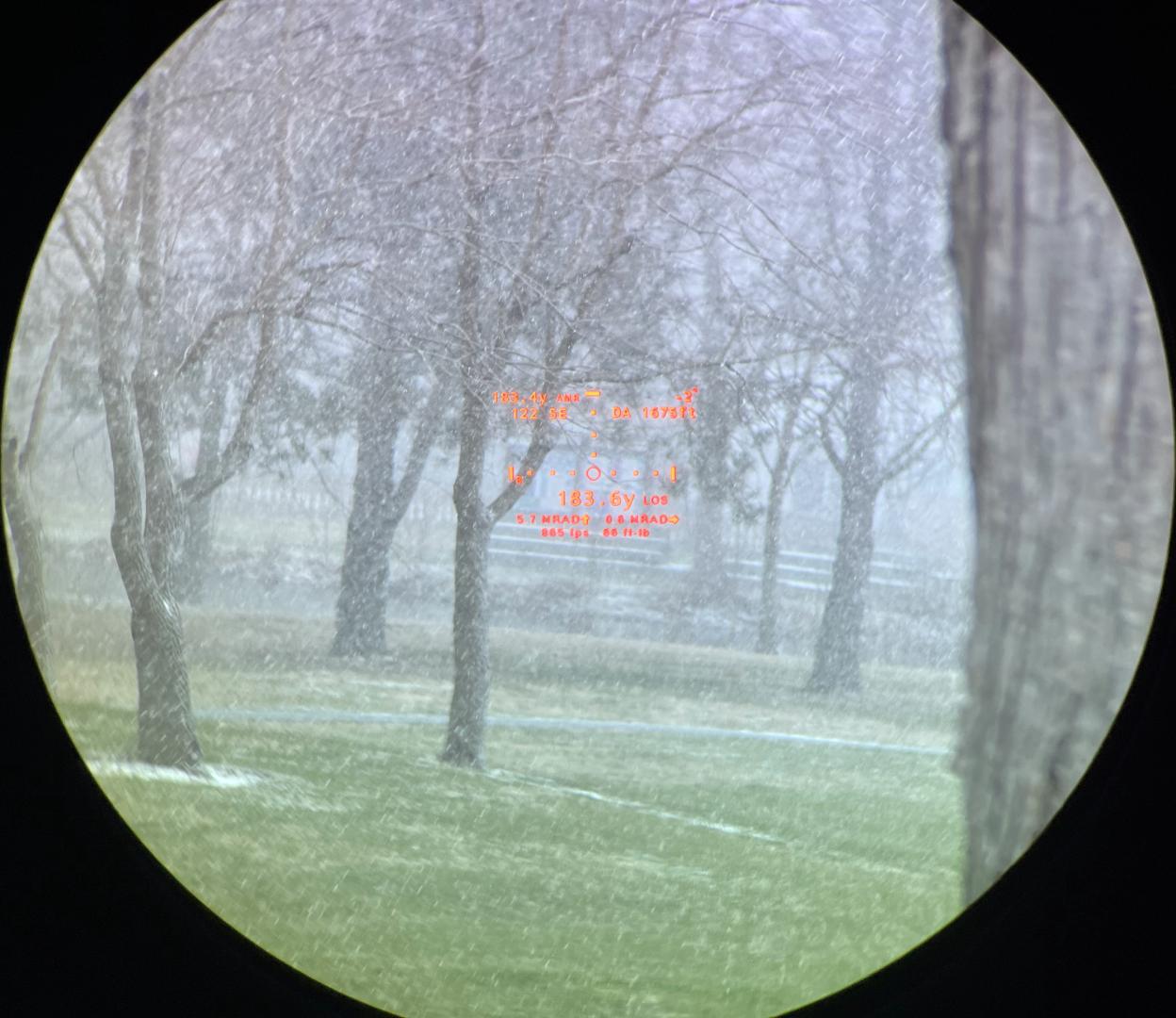
Different Onboard Sensors:
Simply as on the Gen I Sig 10ks, the Gen II models include a set of different sensors along with the rangefinding laser. There’s an atmospheric stress sensor, temperature sensor, humidity sensor, angle of inclination sensor, and compass. Sooner or later, additionally, you will have the choice of including the wi-fi Calypso AB version ultrasonic wind meter. A number of the enchantment of an all-in-one rangefinder and ballistic solver is that every one these sensors may be mechanically built-in into the calculations for larger accuracy, pace, and translatability from wherever you zeroed the rifle and practiced to wherever you might be searching. To do that although, the sensors need to be fairly correct. So, I examined them. With its remarkably thorough show, a few of this information (bearing, DA, and inclination from vertical) reveals as much as the person whereas ranging. What doesn’t present up within the ranging display screen is seen within the onboard sensors part of the superb menu system within the binoculars.
Over a number of totally different periods I’ve discovered the temperature sensor to remain inside about 5 levels of the native climate information from the airport fairly close to my dwelling indicating it’s adequate for it’s objective. As many have famous, the temperature sensor could be very gradual to regulate, taking 20 min or so to acclimate to its location. The temperature sensor can also be simply thrown by direct daylight heating up the binoculars themselves. This has been true of all laser rangefinding binoculars I’ve encountered and Sig has included an choice to manually set and lock the temperature inside the binoculars or, if you’re utilizing the app and in cell vary, you’ll be able to set the temperature based mostly on the closest climate station. I might counsel both of those choices if you’re utilizing the binos for prolonged time in direct daylight. As with the temperature sensor, I discovered the atmospheric stress sensor lots correct for its objective. It combines with the temperature and humidity settings to supply a density altitude quantity used within the ballistic calculator. This quantity has sometimes agreed with that of the airport inside 500ft or higher offered the temperature was appropriate both by setting it or letting it acclimate however not in direct daylight. The Sig 10ks even have an angle of inclination sensor. This examined inside a level and a half or so of appropriate, which appears greater than adequate to the aim.
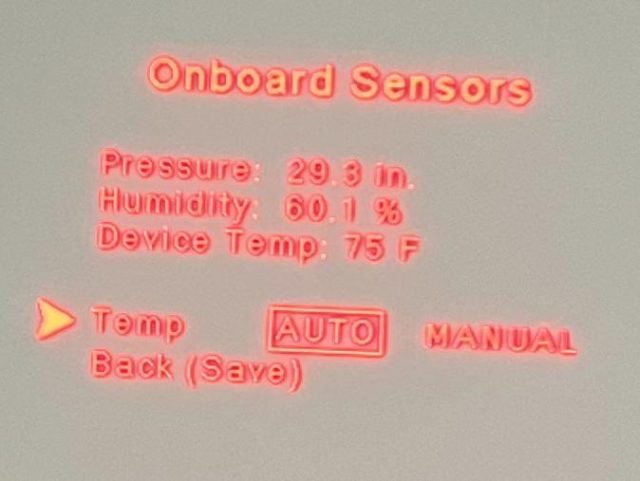
Whereas all of those sensors within the Gen II 10K models examined roughly just like the Gen I’s sensors, my testing indicated the compass within the Gen II unit was considerably improved from the Gen I unit. I later verified that the Gen II models do even have a unique, higher, compass chip. These little chip sized compasses are very finicky each when it comes to their precision and their accuracy. They’ve little impact on the ballistic calculations (Coriolis is basically not a giant impact) however they’re one of many major parts to putting a distant GPS level the place you could have ranged on a map for recreation restoration. This function is mentioned within the background on GPS mapping and Basemap part close to the tip of the assessment for these . Sig has additionally integrated an export map level function instantly into it’s personal software program so you’ll be able to select to export the ranged level to Google maps, Apple maps, or onX. On the Gen I 10K’s I usually noticed ten diploma swings within the compass studying for ranging the identical goal. With the Gen II models I’m seeing extra like a five-degree vary of studying. That may be a substantial enchancment for these utilizing distant GPS factors.
Ballistic Software program:
In scripting this assessment, I fell like I’m returning to the BDX software program after two years. It isn’t that I’ve stopped utilizing the Gen I Sig 10K binos I reviewed at the moment. Certainly, up till the time this years rangefinder assessment gadgets landed on my doorstep for assessment my go-to rangefinding machine and ballistic calculator was the Gen I Sig 10K binoculars and I took them with me each time shoot lengthy distance. The explanation for the shortage of utility use was that the binoculars retailer 30 ballistic profiles and their menu system is so sturdy that I simply didn’t want to make use of the appliance. Certainly, the binoculars even talk instantly with the BDX 2.0 geared up Sierra6 BDX scope. I assume if I had been making an attempt a bunch of various ammo in that point I might have wanted to interrupt the app again out to make new profiles however I wasn’t doing a complete lot of ammo or load experimentation in that point so it simply didn’t occur. Truthfully, I discovered myself slightly excited to see if something had modified within the software program.
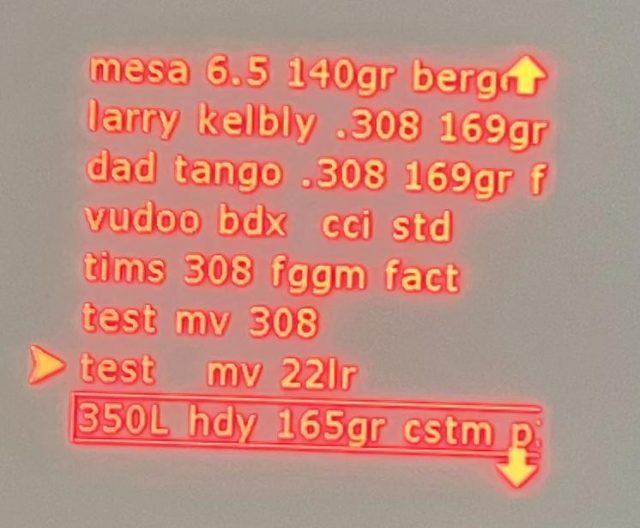
I’ll begin the BDX software program dialogue with these modifications. In all probability the most important one is the choice to cloud sync your ballistic profiles. This isn’t pressured on you as some software program makers are all the time making an attempt to do however does will let you again up your ballistic profiles remotely if you want. Login for that is automated utilizing your Apple or Google ID. For these curious, this doesn’t create a single common AB profile storage that lets you transfer your ballistic profiles from say your Leica Geovid Professional to your Sig 10k Gen II. For now, at the very least, profiles are restricted to particular firms apps. Sig has included an fascinating switch function between it’s personal gadgets nonetheless. This function is the flexibility to share a selected ballistic profile with a pal by way of QR code. So, in case you and and a buddy each use Sig rangefinders, you’ll be able to immediately switch your profile to his app so you’ll be able to simply have all profiles on one rangefinder for a match. Establishing a profile to switch by QR code is finished by hitting the odd trying image beside “profile editor” close to the highest proper of the profile modifying display screen for the profile you wish to switch. This brings up a QR code. On the machine you propose to repeat the profile to, you begin creating a brand new profile and select the underside “scan code” choice for profile kind. Then you definitely scan the code and it’s carried out.
Different modifications to the BDX app embrace transferring the ballistic correction models from the final menu to the precise ballistic profile menu to account for individuals who have each mil and MOA scopes on totally different rifles. Lastly, Sig has elevated the variety of choices for dropping a distant level on a map. On the time of the preliminary launch of the 10k, you may solely drop a distant map level from inside BaseMap. You now have the extra choices of exporting a ranged level to Google Maps, Apple Maps, or onX. These choices are discovered on the energetic ranging display screen inside the settings tab. Choosing one in all these export choices prompts a pop up on the ranging display screen that prompts you to provoke the export of the final goal ranged.
Now we are going to speak in regards to the options of Sig’s app that haven’t modified since I final visited it. All of Sig’s BDX rangefinders and scopes use the identical BDX grasp app whether or not they’re based mostly on AB elite or AB Ultralight. This app differs from different Utilized Ballistics purposes in that it has the large added perform of together with the Sig BDX 2.0 system. The App’s startup display screen is indicative of the breadth of stuff the app is meant to do, having sections for the totally different gadgets you could have paired with the app, in addition to your ballistic profile creation part, the pairing menu, and a pair informational sections. Be aware that the video and handbook part is definitely only a hyperlink to your net browser. It is a bummer because it doesn’t work offline, and I think a couple of individual has actually, actually, wanted it to take action whereas on a hunt. Be aware to Sig, our telephones have sufficient reminiscence to combine the handbook into the app so it really works offline. It is a wonderful handbook by the way in which. I can’t say that the association of the BDX app is my favourite of the AB apps. It’s ranging display screen is the 4th tab down underneath “rangefinders” and sits beneath the tab “ballistic teams” that’s an informational reference part solely germane to these utilizing Sierra BDX riflescopes and provided that they’re utilizing the “SmartBDC” teams of comparable cartridges perform as a substitute of programming a profile particular to the precise ammo and rifle getting used. I’ve gotten used to the structure over the time that I’ve used the app, however I feel the above is an efficient instance of how typically the ordering of things and labeling of classes appears slightly counter intuitive.
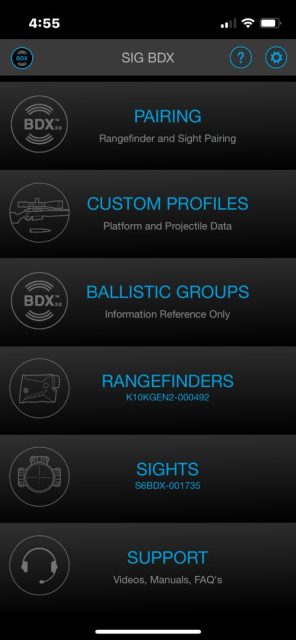
Because the Sig Kilo 10k-ABS HD comes with Utilized Ballistics Elite, the majority of this assessment will probably be centered on navigating that. I ought to word although that the binos do produce other ranging modes together with LoS, AMR, exterior ballistics (for Kestrel or exterior machine calculations), and even an archery mode (for prime angle lengthy distance archery pictures).
The Utilized Ballistics Elite constructed into the Sig 10k binoculars and enabled within the BDX utility when it’s linked to these binoculars, navigates the identical because the AB Ultralight. Having elite simply unlocks just a few extra choices within the Customized Profiles part than these utilizing this utility with a rangefinder solely geared up with AB Ultralight would see. These choices embrace entry to customized and private ballistic coefficients inside the AB library, adjustment for twist price, sight peak, sight scale (an adjustment for when your scopes changes are slightly off in adjustment magnitude), some velocity scaling for temp, and some different offsets you’ll most likely by no means use. After all, it additionally offers you ballistic options for >800M pictures. You’ll word that there isn’t a part within the ballistic profile display screen for truing muzzle velocity to discipline information or including a drop scale issue for supersonic to subsonic transition. These features are solely accessible from the reside rangefinding display screen and solely work with ranges you could have simply taken, reside. You can not enter beforehand recorded information. This isn’t my favourite alternative. I would love to have the ability to extra simply mess with this stuff when not on the vary and have the ability to each mess with them and the vary card to see how the info is lining up with my field-recorded information. Whereas I can actually nonetheless mess with the muzzle velocity within the old style, non-automated approach, there isn’t a different method to entry the drop scale issue. If I, an individual who actually doesn’t shoot previous supersonic a lot, wish to do this, I’m certain the ELR guys do as effectively, and plenty of them are going to be taking a look at this product. Make it so we are able to manually enter these things and futz with it. This incapability to make use of the truing perform unconnected from rangefinding additionally makes it too cumbersome to be possible to true each BC and MV in {a partially} automated approach. That is one thing that you may normally do with out an excessive amount of issue solely when you’ve got an automated truing perform for one of many two. Lastly, I ought to word right here that the identical system exists within the BDX software program for truing MV (although not DSF) for these with solely the Ultralight model of AB. AB Ultralight doesn’t normally embrace any automated truing perform. That, coupled with some integration with atmospherics, might be why truing is a roundabout system on the Kilo 10k, although is comes with AB Elite. I nonetheless need to have the ability to simply manually mess with these things, although, and subsequently disagree with Sig’s decisions on this regard. This truing perform additionally refuses to do the automated truing for all cartridges besides .22LR when the vary used is inside 300yds. It is a unusual and annoying prohibition as there are different gradual calibers you may wish to true at lower than 300yds corresponding to straight walled Midwestern deer rounds and 300 actually isn’t adequate for truing the massive quick stuff anyway. The app can also be not the very best at figuring out a .22lr profile and so blocks shut truing with a few of the .22lr profiles as effectively.
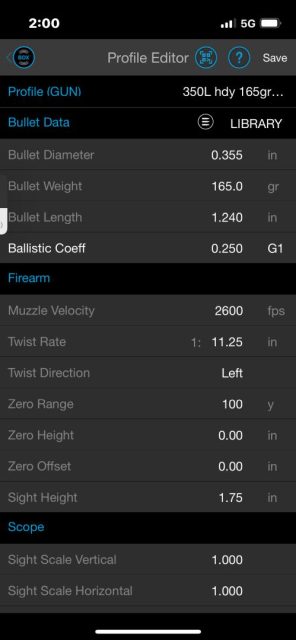
The Sig BDX utility offers you a great deal of management as to what and once you sync data with the binoculars. This offers you the flexibility to carry extra profiles inside the app than the 30 that may be concurrently within the binos. Due to the Kilo 10k’s massive show capability, a considerable amount of textual content may be displayed for every profile identify, making it fairly straightforward to maintain monitor of which one is which. You by no means have to recollect simply which information is saved underneath some generic ‘Profile 1’ designation. I’m telling you, the menu system within the binos is so good you’ll not often really feel the necessity to join them to the app.
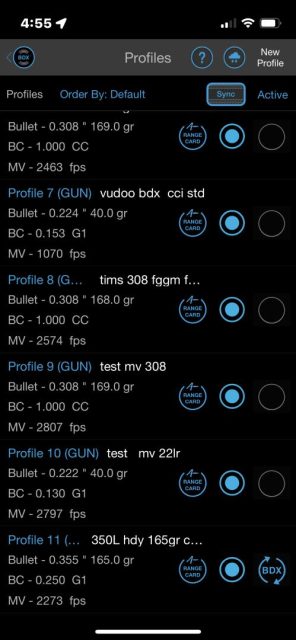
Abstract and Conclusion:
Following up the class altering success of the primary era of Sig Kilo10k-ABS HD rangefinding binoculars is a job I wouldn’t want on anyone. These binoculars ranged two to 3 instances additional than their closest rivals and featured a 304x 256 pixel AMOLED show that used 1/twentieth the power of rivals choices whereas permitting for a strong and straightforward to navigate menu system that every one however obviated the necessity to pull your cellphone out within the discipline. Additionally they featured Utilized Ballistics elite baked in. The 10ks weren’t the primary to combine this software program, however it was nonetheless a reasonably new and unusual function and Utilized Ballistics had simply began their cellular check lab leading to a quickly increasing customized ballistic mannequin library making that function much more useful. With out query, the Kilo10ks had been a recreation changer.
What this second era of the Sig 10k’s represents is a refinement of it’s revolutionary progenitor, not it’s personal revolution. It eliminates the blue tint, yielding a dramatically improved person expertise, provides three extra buttons for faster wind enter and higher menu navigation, improves ergonomics for extra snug use and higher cinch strap compatibility, and improves the interior compass. This stuff make the second era unquestionably a greater product with a much more refined person expertise. It’s not going to provide the similar rush as earlier than although as a result of you could have seen it’s finest options already. These finest options are the Sig Kilo10k-ABS HD’s class main rangefinding capability, it’s 304 x 256 pixel AMOLED show and it’s integration of Utilized Ballistics elite.
The largest of the modifications within the second era of 10k binoculars is certainly the removing of the dreaded blue tint. Whereas the optical efficiency in any other case seems unchanged, this ends in an enormous enchancment in person expertise. The ensuing picture seems a lot brighter and extra vibrant making the binoculars a pleasure to make use of as binoculars and never simply as a housing machine for a rangefinder and ballistic calculator. They aren’t optically aggressive with Leica Geovids, Vectronix Vector X’s, or Swarovski EL ranges, however they’re aggressive with mid stage non-rangefinding binoculars corresponding to Zeiss Conquests. I discover them to be good optically and that could be a good distance from the mediocre I discovered their predecessors.
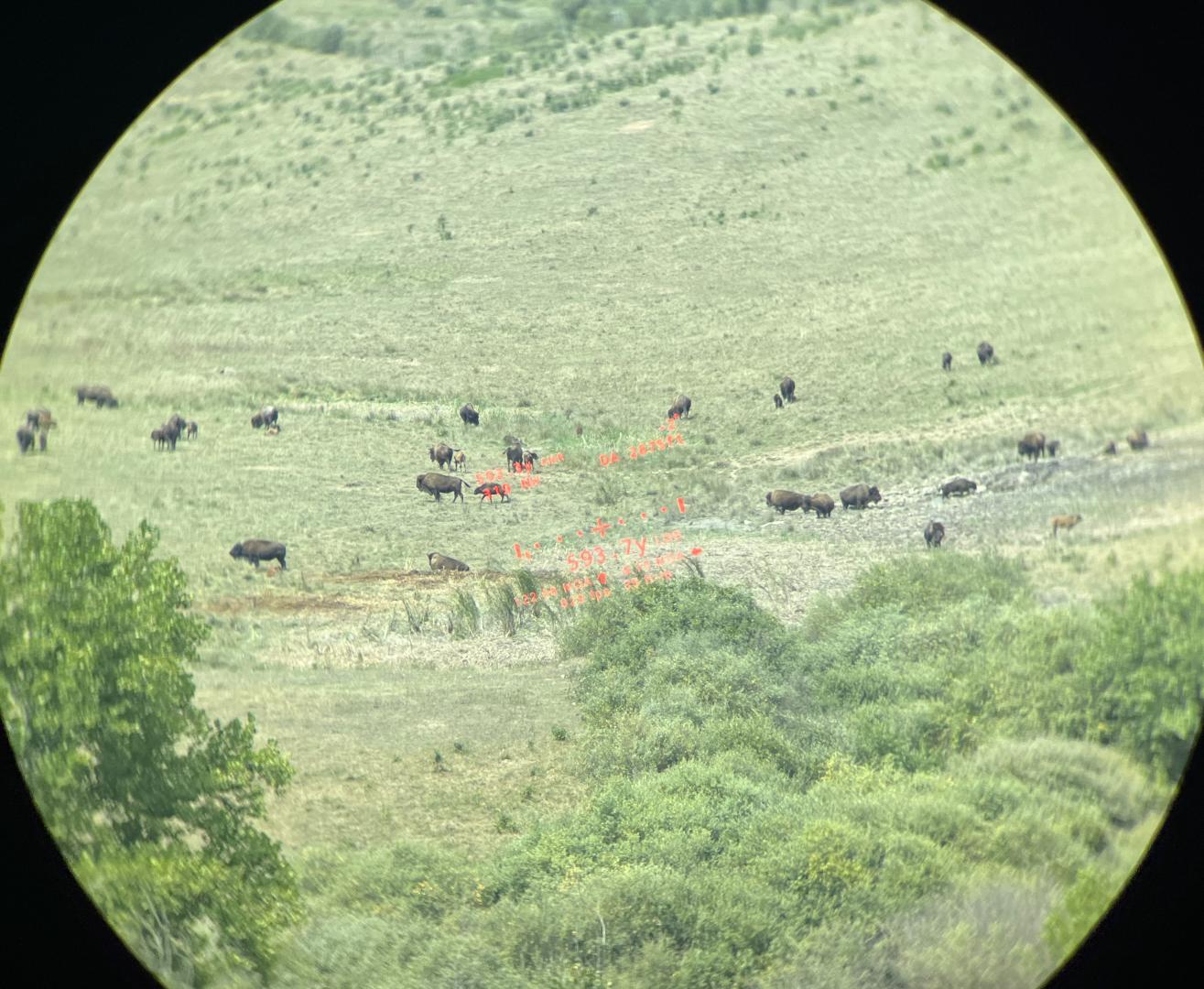
In my expertise, the Sig Kilo10k-ABS HD Gen II Binoculars, regardless of the change from class 1M to class 1 don’t have any noticeable change in vary discovering efficiency from their progenitors. They once more ship on their lofty best-case situation ranging promoting guarantees. The 10ks will vary arduous targets at 10k yds (at evening), tree traces at 4,000 yards (even on some shiny sunny days), and deer at 3,000 yards (that is going to have to be a giant deer and an overcast day.) The tight 1.5 x .06 mil beam dispersion even permits for some fairly improbably far outcomes on small targets corresponding to with the ability to vary an individual at 2,100 yards. Full disclosure, that consequence was with a gen I unit as I used to be not capable of get nearly as good of circumstances or as fats of a topic this yr any time throughout my testing of the Gen II unit. As with all rangefinders, circumstances vastly impact the potential efficiency however you may be arduous pressed to have difficulties inside of two,000 yards with the 10ks. The 10ks ranging can also be quick. Although solely by spit second margins, I imagine they’re the quickest vary discovering binos I’ve examined.
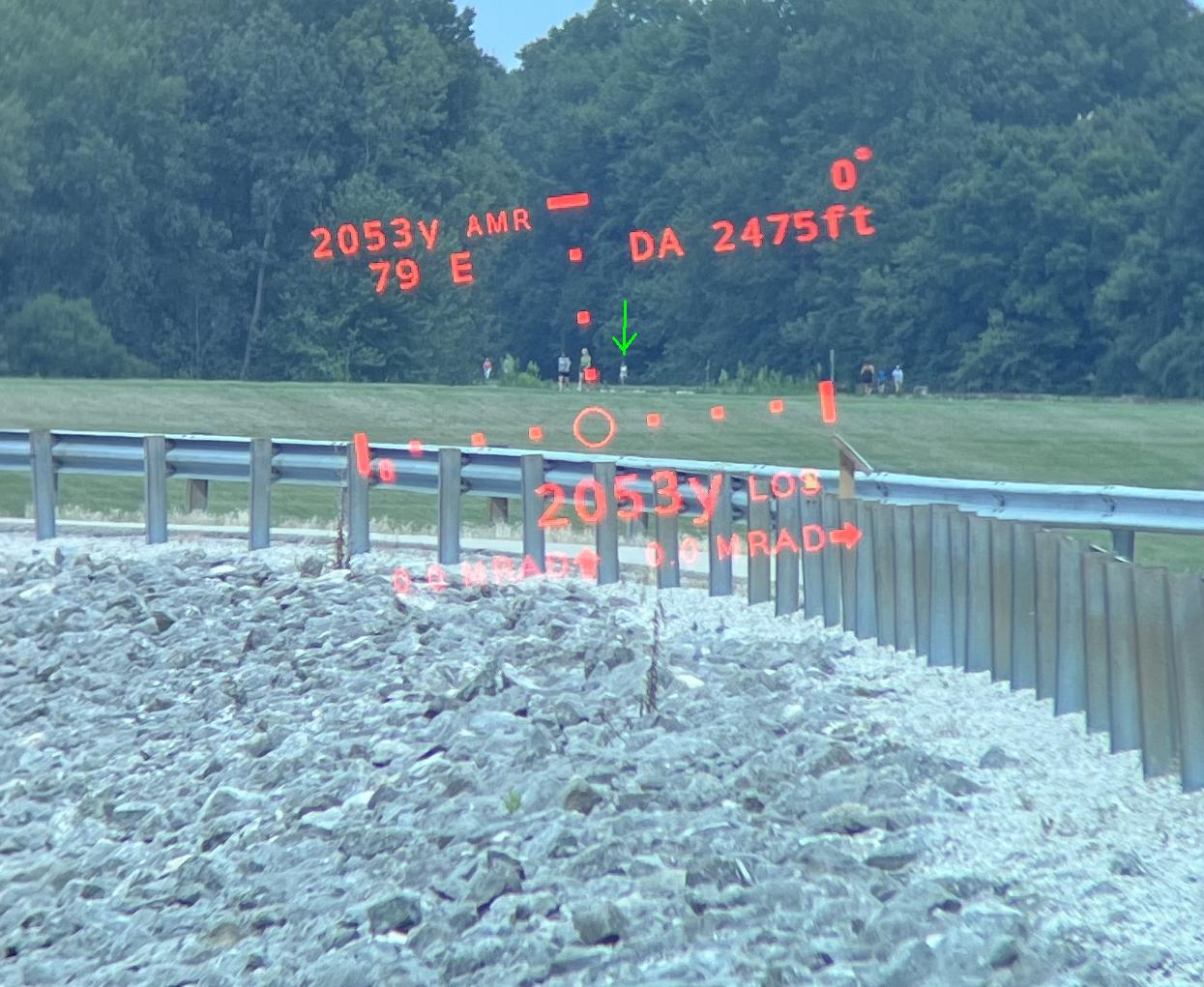
For the reason that launch of the primary 10k binos and going into this second era, Sig has added numerous options to their taste of Utilized Ballistics Utility. These included extra map software program choices for dropping a distant ranged level, cloud syncing of ballistic profiles, and the flexibility to simply make the most of a combined mil / MOA secure of kit. I nonetheless discover their taste of Utilized Ballistics a bit clunky although. Whereas I can see it’s utility within the wonderful BDX 2.0 system, it doesn’t shine for AB elite exterior of that context. It’s locking the truing features behind a tedious wizard within the energetic ranging menu and synthetic constraints truing distance are irritating and I discover a lot of the menu structure to be much less intuitive than different implementations. It may additionally use a reside ranging automated goal card building function.
For the reason that time of the unique 10k launch Sig has massively boosted it’s guarantee protection. Sig Kilo electro-optics now all carry an business main limitless, transferable, lifetime guarantee. It is a tremendously higher guarantee than most competing optics supply and plenty of peace of thoughts when investing the kind of cash it takes to purchase a high tier multi functional optical, rangefinding, and ballistic calculating answer.
Background on Ballistics Calculation, Modeling, and Utilized Ballistics Elite:
For a very long time, ballistics calculators have just about all used the identical underlying math, which is actually based mostly on the measured trajectories of two primary examined projectiles, these being the G1 and G7.

Every software program would iterate from these underlying measured trajectories utilizing a comparability issue referred to as the Ballistic Coefficient. This coefficient established a comparative diploma of aerodynamics between the shooter’s particular bullet and the G1 or G7 commonplace, in line with which the formulation would stretch and deform the unique G1 or G7 measured trajectory to be extra like what can be anticipated from the person’s bullet. That is the place the G1 and G7 BC numbers in your bullet field come from and what they imply.

In observe, the standard course of utilizing G1 or G7 based mostly software program was to measure the rate of your rifle when establishing your 100 yd zero or when growing a brand new handload to your rifle, then plug that worth together with the BC on the field and your atmospherics into your software program to get an preliminary set of ballistic options for various distances. These would in fact be incorrect by just a few tenths of a mil or in order you bought additional out. You’ll write down the true field-recorded values after which fudge with the BC and / or velocity till the mannequin being spit out was as near appropriate as you may get it. This new mannequin can be useful in spitting out good numbers for various untested distances or on days with totally different atmospheric circumstances. It wouldn’t be good and, with all of the guessing and checking, it will take some time to get to, however it will be useful.
After all, the mannequin confronted some limitations as a result of your bullet shouldn’t be truly formed like both the G1 or G7 commonplace. Its trajectory is basically not only a G1 or G7 trajectory stretched a bit. Moreover, you might be firing it from a gun a bit totally different from regardless of the check gun was in these unique trajectory research, at a unique preliminary velocity. All this issues. The underside line is that there’s a restrict to how precisely you’ll be able to stretch the G1 or G7 trajectories based mostly on only a BC quantity and preliminary velocity quantity, and that restrict is not so good as many people would love it.
Due to this, a few firms have begun measuring the trajectories of extra projectiles from extra rifles fired at extra velocities. That is the origin of Utilized Ballistics’ Customized Drag Fashions (CDM) and Hornaday’s Bullet-Particular Drag Fashions. Software program based mostly on these libraries, corresponding to Utilized Ballistics Elite, can output higher distance compensation values than that which relies on G1 and G7 values as a result of the underlying trajectory curves are these of the particular bullet in query. For extra element on these modifications in ballistic calculation, Cal Zant did a superb article on Bullet-Particular Drag Fashions and Frank did a pair interviews with Brian Litz and Emil Praslick for the On a regular basis Sniper podcast.
Moreover, the rangefinding software program inside industrial rangefinders has additionally shifted over time: first solely providing just a few inventory choices for preset ballistic curves; then permitting you to enter your personal G1 or G7 based mostly ballistic profile that you just needed to, by guess and examine, true to your precise discipline outcomes; and now beginning with a customized drag mannequin and having a truing perform inside the software program that eliminates the tedious guess and examine truing. When utilizing software program with a truing perform, you merely enter just a few of your discipline outcomes for recorded drop at a identified distance and the software program advantageous tunes the customized drag mannequin, sometimes its preliminary velocity, to suit your information.
Having spend a great deal of time with Utilized Ballistics Customized Drag Fashions over the past two years I’m very impressed with the development this engine provides over conventional G1 and G7 fashions in addition to what number of bullets have been added to the CDM library and the way frequently it’s up to date. You’ll now discover mainly something utilized in lengthy vary competitions in addition to fairly numerous searching bullets. Have been speaking plenty of bullets, 447 on the time of writing for six.5mm alone as an example. My expertise is that these customized fashions are considerably higher out of the gate than conventional fashions to the purpose that (assuming you already know your muzzle velocity) they incessantly require no truing to be appropriate all the way in which out to transonic distance. Within the occasion that you just do must true the rate, that is rather more simply achieved although the truing perform within the software program than by conventional guessing after which re-testing as was carried out in earlier calculators. The tip consequence trued up mannequin can also be usually higher than was produced utilizing older G1 and G7 software program as I usually beforehand produced fashions that will be off by a tenth mil or so at a ways and I used to be unable to treatment this with MV or BC modifications to the formulation with out messing up another a part of the curve. This software program has vastly improved my confidence in my information when interpolating or extrapolating to distances I’ve not particularly gathered dope on or in circumstances totally different from which I gathered the dope in (the LRF binos in query collect information on and compensate for temperature and stress). I’m lacking rather a lot fewer targets, spending rather a lot much less time crunching numbers, and chasing my tail rather a lot much less in miss evaluation as effectively.
Background on How Laser Rangefinders Work
As with most instruments in life, a greater understanding of the ideas behind, and idiosyncrasies of, the device’s perform usually ends in extra skillful use and higher outcomes. The aim of this part is to assist familiarize the reader with simply what a laser rangefinder truly sees and the way it analyzes and conveys this data to the person.
Although a wide range of strategies can be utilized to evaluate distances utilizing lasers, nearly all of laser rangefinders, together with this one, make use of a time-based calculation for distance. What this implies is that the heart beat is distributed out and bounces again, after which the time between these two occasions is used to calculate the space. That is straightforward sufficient in precept. In observe, nonetheless, we’re not speaking about one laser pulse however many, and a wide range of different elements additionally complicate this, so the ensuing information requires some interpretation. Crucial of those elements are beam dispersion, refraction, and background radiation.
Beam dispersion refers to the truth that the form of a beam being emitted from the vary finder is a cone, with the broad base oriented to the goal, and never a rod. That’s, the beam spreads out and covers extra space the additional the item being ranged is from the rangefinder. As well as, most rangefinders, this one included, emit a beam that’s not spherical in cross part, however reasonably nearer to rectangular.
Within the case of this explicit rangefinder, the divergence is .06 mils within the vertical by 1.5 mils within the horizontal. The Sig Kilo 10ks are distinctive in offering the person the flexibility to align this beam to the reticle manually inside the BDX smartphone app. It will be important that you just do that as it’s unlikely it is going to be ideally aligned out of the field, simply as it’s unlikely most different rangefinders could have a wonderfully aligned beam. The distinction is that you may align the 10k your self whereas most others you simply need to make a psychological word on the alignment and reside with it. For many makers, a cross for beam alignment on QC means solely that some portion of the beam touches some portion of the reticle, not that it’s correctly centered. Certainly when examined, the beam on this 10k was simply barely touching the sting of this reticle. To middle it utilizing the alignment perform inside the BDX software program, an adjustment of -4 within the horizontal and +1 within the vertical was needed. Having the ability to do that is a lot appreciated, as a small misalignment can matter an awesome deal when ranging small objects distant. In figuring out your alignment, you’ll be able to fairly simply see the beam with a nightvision system, because the rangefinder’s 905nm beam is within the spectrum the nightvision sees. Nonetheless, in case you don’t have nightvision, as I don’t, there are a few methods to determine the alignment. The simplest might be to discover a good, flat, small signal roughly the scale of your reticle when its a pair hundred yards away and see how far proper, left, above, and beneath, you’ll be able to goal and nonetheless get the vary of the signal. I did this with the beneath pictured rectangular industrial gentle and adjusted the beam increment by increment inside the BDX software program to middle it. Bear in mind, you’ll be able to flip the binos upside-down or sideways throughout testing to make certain to not get returns from the put up once you’re looking for the underside fringe of your beam. Additionally of word when adjusting the reticle alignment on the 10ks, is that you just deal with the ranging inside the program throughout the course of and never from the binoculars vary button.
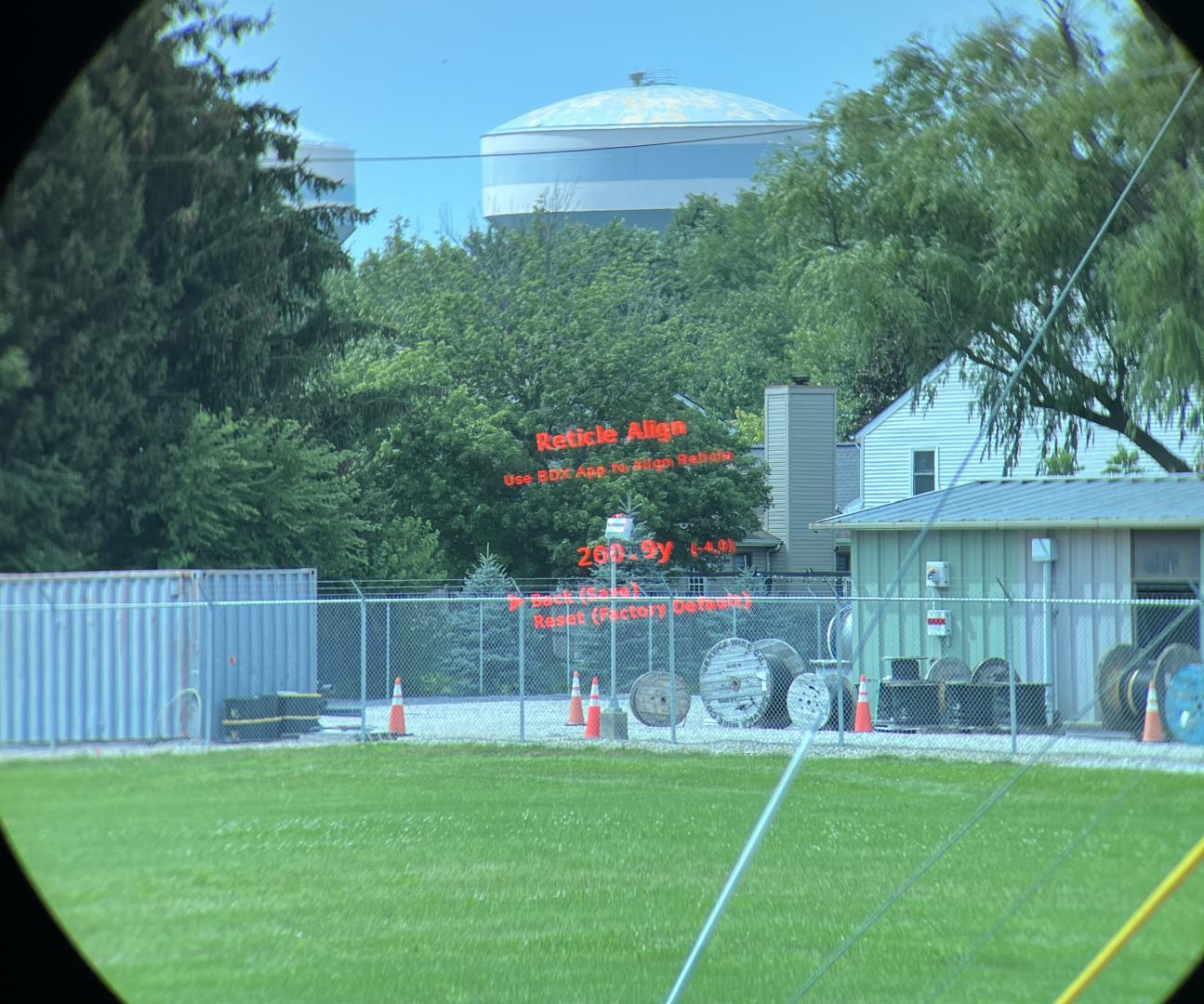
Along with alignment, it’s also vital to grasp simply how massive a laser rangefinder beam will get at longer ranges. Presently, common beam dispersion for a laser rangefinder is one thing like 2 x 1 mils. That is 7.2″ broad at 100 yards, or 72″ at 1000 yards. With this sample, if you’re making an attempt to vary a goal at 1000 yards, except it’s an elephant, a lot of that beam will probably be reflecting again from what’s round and behind the quarry and never the animal or, extra probably at that vary, metal itself. More often than not, a rangefinder could obtain a sign comprised principally of sunshine not mirrored off of the goal. Knowledge evaluation will subsequently be needed to choose the goal out from what shouldn’t be goal. Comparable in impact to this, many targets usually are not completely flat and perpendicular to the rangefinder. As a result of the beam is broad on the goal finish, which means that what’s mirrored again won’t be a single sharp sign however numerous totally different reflections at numerous totally different distances. Should you goal at a hillside, as an example, some will probably be mirrored off the nearer backside of the hillside, some off the additional high, and a few off every thing in-between. A tree may even give a broad studying as it’s a three-dimensional object with reflective components and items all through. What the rangefinder truly sees, subsequently, is to not be represented as a single blip at a single distance, however reasonably a plot of many returns at many distances with a wide range of peaks and valleys equivalent to distances at which just a few (valleys) or many (peaks) of the laser pulses had been mirrored again. The rangefinder could perform all of the interpretation of this plot itself or it could permit the person a point of management. In idea, a rangefinder may additionally current your entire plot to the person for interpretation, although I’m not conscious of any fashions that do that. This Sig 10k, with its pixel-based show, is likely one of the few that theoretically may, although it doesn’t. It does, nonetheless, offer you a considerable amount of alternative in information evaluation. The rangefinder’s menu consists of modes for final (choose far goal), first (choose close to goal), finest (goal with largest returns), XR (choose furthest goal and extra ranging pulses will probably be despatched out over an extended time), and fog (totally different processing algorithm to reduce faulty returns.) That’s a great deal of alternative, and given the superb menu system of the 10ks, it’s straightforward to entry and make the most of this perform.
Refraction refers back to the bending of sunshine by way of mediums of differing density corresponding to air or water. The heartbeat despatched out by a rangefinder should journey although a substantial amount of medium earlier than returning. This air could have a wide range of totally different temperatures and moisture contents. It might additionally include microscopic or macroscopic water droplets. All of this, in addition to mud within the air, will serve to scatter or take in the laser such that a lot of the beam will both not hit the goal or not return. The impact of this can turn out to be extra pronounced with distance on the similar time that beam dispersion dictates that the beam is extra unfold out with distance. This works collectively such that the additional an object is, the much less sign may probably be mirrored off of it. At some vary, subsequently, the sign won’t be robust sufficient to be distinguished from the final of your vital elements. Moreover, in case your rangefinder is of the upper energy 1500nm selection as a substitute of the extra frequent 900nm selection (these Sig 10k binos use a 905nm laser), absorption and scattering turn out to be a a lot larger deal. 1500nm lasers work together closely with water and so turn out to be far much less efficient the extra water is within the air.
Background radiation is omnipresent however varies vastly with atmospheric circumstances. At evening, in case you may see the goal to vary it, you wouldn’t have a lot of an issue. On a shiny day, nonetheless, the solar is introducing an incredible quantity of electromagnetic radiation that’s reflecting, refracting, transferring power to things, and being radiated as soon as once more at totally different wavelengths. A few of this cacophony of radiation will probably be shut sufficient to the wavelength utilized by the rangefinder to be picked up. This radiation will type a flooring to the doable sign power returned from the item ranged that could possibly be learn.
I’ve made the next crude diagram of what the person, and the rangefinder, may see in a selected contrived situation as a way to assist the reader to grasp the kind of information a rangefinder is likely to be deciphering. This isn’t strictly correct because the rangefinder doesn’t ship one beam out and report a bunch of various returns however reasonably sends out a complete bunch of tiny pulses and information a return for every. In different phrases, the theoretical return plot I present is far smoother than precise information would look, although the form is identical. I feel this fashion of depiction is most helpful in serving to the person to grasp what a rangefinder sees, although. It might additionally assist the person, the place doable, to current the rangefinder with situations the place it might need a better name to make. In different phrases, to goal to get higher returns,typically, by ranging easier-to-read gadgets close to in proximity and distance to a small desired goal as a substitute of that focus on itself.
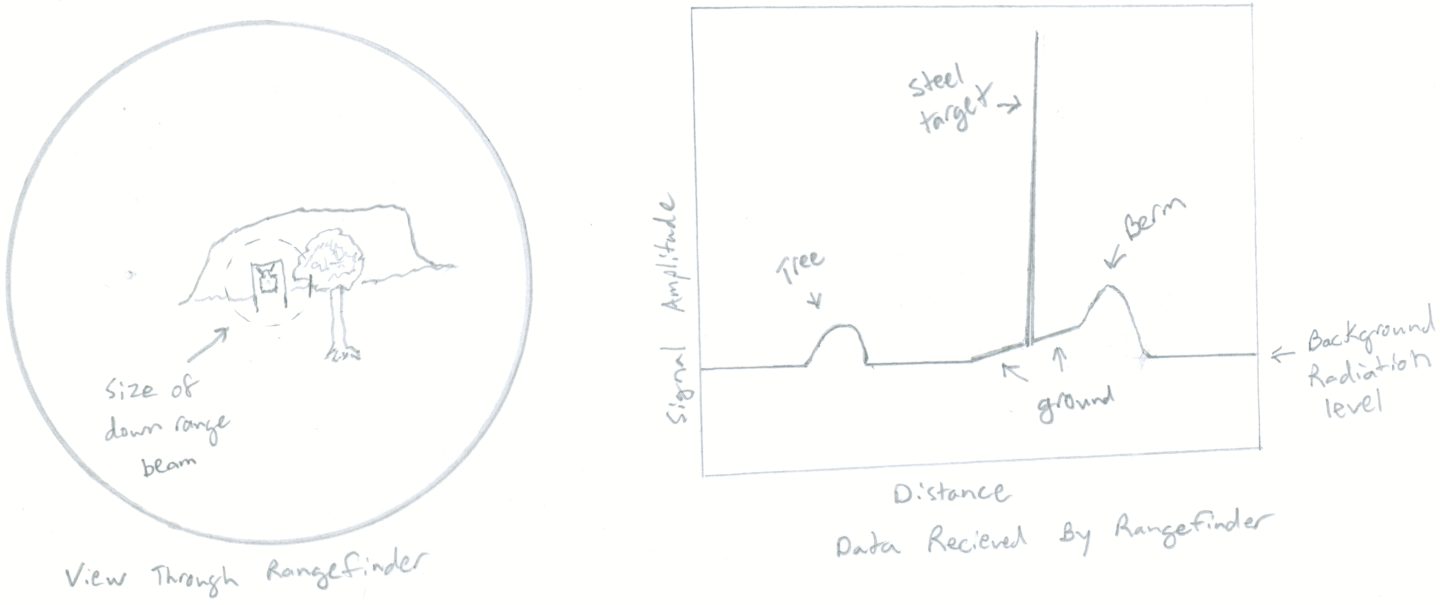
As you examine the above diagram and plot, consider the next doable methods by which the info is likely to be interpreted by the rangefinder and the way these interpretations would impact the person not solely on this instance state of affairs, the place the metal goal is the specified object to be ranged, however in different situations as effectively: maybe when ranging softer targets in opposition to arduous or absent backgrounds.
1) A rangefinder is likely to be programmed to show the closest peak in amplitude to the person. This might be the tree.
2) A rangefinder is likely to be programmed to show the furthest peak in amplitude. This might be the berm.
3) A rangefinder is likely to be programmed to choose the height with the best space beneath. This usually corresponds to the item filling the best space of the diverged laser beam down vary. On this instance, this is able to be the berm. 4) A rangefinder is likely to be programmed to choose the height with biggest most amplitude. This normally corresponds to any object that’s sufficiently massive, reflective, and principally perpendicular to the shooter. On this case, that’s the metal goal.
Most rangefinders are programmed to choose one in all these standards to find out the vary from. A couple of have a number of modes you’ll be able to change between. These sometimes will let you set choice for close to / first goal (tree), far / final goal (berm), or highest variety of sign returns / finest goal (berm or metal relying on particular standards). The Sig 10ks have modes for every of those and these modes are simply discovered within the binoculars menu system underneath “Goal Mode”
Background on the Challenges of Getting Optical Efficiency from a LRF Bino:
Producing laser rangefinding binoculars of excessive optical high quality is a troublesome proposition. However, it is a essential space of efficiency as a result of the thought of LRF binos isn’t just to switch a small rangefinding monocular, but additionally to switch the binos you utilize to seek out and observe your quarry. For such objective, LRF binos want rather a lot higher optics than the small, darkish, heavily-tinted view you get by way of slightly handheld LRF monocular unit.
Amongst the difficulties confronted in designing optically excessive performing LRF binos, foremost are the impact of the show on optical efficiency and tips on how to combine the laser optic parts with these for seen gentle. You might have some robust choices to make in relation to coatings because the laser transmitter and receiver are a part of the optical system, in the best barrel. The laser wavelength used, 905nm, is simply exterior of the seen gentle spectrum. This laser gentle should each cross by way of and make the most of a lot of the optical system used for the seen gentle touring to the person’s eyes and be diverted from the remainder of the incoming gentle at a degree to be redirected to a receiver positioned within the barrel. Clearly, it is a coatings problem.
The opposite important optical problem of laser rangefinding binos is the impact of the show on optical efficiency. There’s merely no method to put a show shiny sufficient to see within the optical path with out some diminution of transmittance. Moreover, to an awesome extent, there’s a direct tradeoff between how shiny you can also make the show and what % of incoming gentle the binoculars can transmit to your eye. Should you’re prepared to have a picture by way of the binoculars that’s dimmer, or, say, blue-tinted, your show may be fairly shiny. If you would like the picture shiny and untinted, nonetheless, you might have to go along with much less show brightness and possibly easier, bigger, illuminated digits. The explanation for that is that your show mainly works by bouncing the show picture off a lens in the primary optical path. This requires some semi-reflective coating, as on a holosight or crimson dot. These coatings take in gentle and the extra you need them to mirror the sunshine in entrance of them (for a brighter show) the extra they take in the sunshine behind them (what you’re taking a look at by way of the binoculars). The problem of sunshine absorption of this nature is powerful sufficient that two of the makers of optically superior laser rangefinding binoculars have opted for uncommon decisions in prism design, partially to counter the sunshine loss. Leica, on its Geovid sequence, has gone with a Perger-Porro prism design, whereas Zeiss went with an Abbe-Koenig prism system. Each of those decisions supply extra gentle transmission and are far much less frequent than the Schmidt-Pechan prisms most frequently merely known as roof prisms which are present in most binoculars, together with the Sig 10ks, Vectronix Vector X, and Swarovski EL ranges.
Background GPS Mapping with BaseMap:
Sig and some different makers have launched the flexibility to mark the situation of a ranged level utilizing BaseMap or different GPS software program. With BaseMap, his function requires the paid subscription Professional model of the software program although, just a few different choices, corresponding to Google maps, are typically free.
The largest aim of distant marking is to assist the hunter to seek out the beginning of a blood path. Usually, after an animal is shot, it usually goes a ways earlier than it dies. As a result of animals don’t perceive what being shot represents, they don’t normally go far if they don’t seem to be actively chased as a result of they neither perceive they’re dying nor that they’re being hunted. They simply really feel harm, then weak and drained. As such, after delivering a shot, hunters sometimes lay low and wait some time to start out monitoring the animal so that it’ll unlikely go far earlier than bedding down and dying. It’s subsequently fairly useful to have an correct level to start out your seek for a path however this isn’t really easy when the sport begins 500yds from you and it’s a must to wait some time earlier than beginning to monitor it. Issues can look rather a lot totally different standing in a discipline than taking a look at that discipline from 500yds. It may be arduous to seek out your start line, and that’s the important thought behind dropping a distant GPS level on it.
Previous to doing 2022’s rangefinder critiques, I had not noodled with the BaseMap software program in any respect. I had heard of it from folks utilizing its satellite tv for pc map to estimate ranges to targets by citing a map of the vary and dropping factors on the map the place it thought the targets had been, however I hadn’t truly tried it. I discovered it a slick software program package deal and have used it numerous instances not along with testing rangefinders. It has a lot of performance round creating routes, measuring distances, and marking campsites, gear drops, and different vital factors. BaseMaps can also be designed for use with out entry to a cellphone sign. This is a vital consideration, on condition that the areas having the very best searching and mountain climbing not often supply cell service. This additionally offers the Sig Kilo 10k, and different makers’ merchandise that interface with BaseMaps, the benefit of working with out cell service, whereas Swarovski’s comparable function makes use of its personal proprietary software program which requires a cell sign. Most significantly from the standpoint of my use, BaseMaps interfaced fairly simply with the Sig binos.
Inside BaseMap, mapping factors whereas ranging them is discovered inside the BaseMap software program underneath instruments and is named “Distant Marker”. After you have paired your binos to the software program, hitting this perform will immediate you to vary what you wish to mark. Once you vary, the purpose will present up in your map with a line from the place you might be standing to the ranged level. You may then select to position a marker at that time, manually alter the marked level’s location, or simply dump the purpose. The software program makes use of three information inputs to resolve the place the purpose ought to go. These are the person’s location as decided by your cellphone’s GPS, the space and angle of the purpose from the person decided by the binos, and the Azimuth of the binoculars, decided by the compass within the binos. The accuracy of first couple of inputs are typically fairly good. Usually, exterior the GPS is nice to inside about 3yds, the vary inside 2yds, and the inclination inside a level and a half or so. In my testing, nonetheless, the Azimuth was solely good inside 20 levels or so. This interprets into numerous error because the distances enhance and boy can these Sig Kilo 10ks vary a good distance.
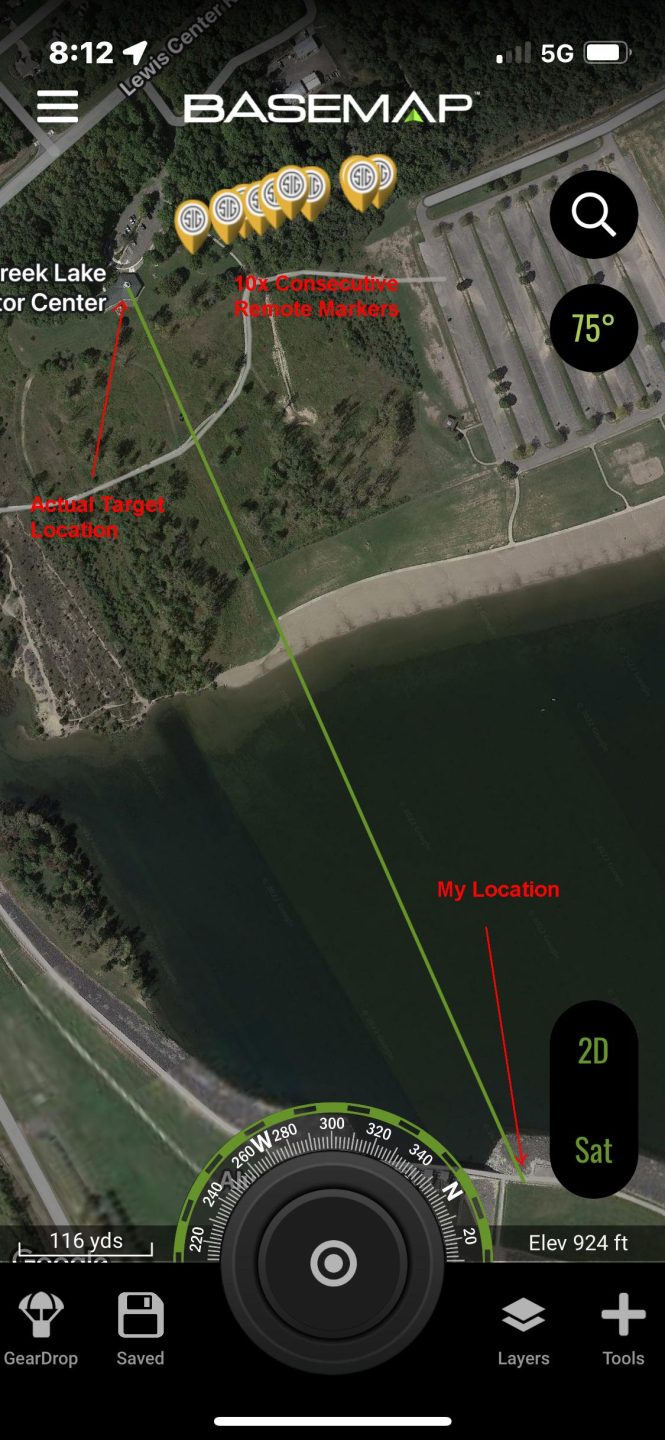
Luckily, this isn’t a random error and we’re not speaking about an space of uncertainty as a lot as a path of uncertainty. There’s little or no uncertainty in both the person’s beginning location or the space of the goal from the person. Subsequently, you’ll be able to fairly simply mark out an arc-shaped path of risk and simply stroll it from one finish to the opposite. You are able to do this by ranging and marking the identical level 5-10 instances. All these factors will line up on a gently arcing path. Its no good, clear, single pinpoint, however it’s nonetheless an incredible help in serving to you discover the animal’s path. Remember that once I did my testing of this function, greater than half the time the proper goal location didn’t truly lie inside the bounds of the ten factors I dropped so when you’re following the arc made by the factors you dropped, you’ll probably want to increase previous the furthest level in every course as a way to attain the goal location you ranged. Frankly, the software program ought to most likely simply mark an arc for you on the map as a substitute of a single level. This might prevent from having to mark the identical level 5-10 instances, and, I imagine, that is what Swarovski truly did. The little chip-sized digital compasses in these and different competing binoculars simply aren’t very correct.




















